Community resilience Anti-oppression
Grassroots power










Community resilience Anti-oppression









STUDENT MEDIA ADVISOR
Tommy Housman
Creative Directors
Auden Phillips
Nina Wilson
Designers
Ale España
Auden Phillips
Emma Moesner
Kennedy Kain
Konner Staley
Myia Payne
Nicholas Kee
Nina Wilson
Rawlston Morton
Sophia Reyes
Tommy Housman
Editors
Callie Knabb
Hannah Bryan
Zorah Mehrzad
Writers
Ale España
Bev Rowley
Elijah Hamilton
Grace Burnell
Grace Gleisner
Hannah Bryan
Heidi McCombs
Jess Wiley
Julia Ribblett
Rachel Hoke
Sophia Reyes
Tommy Housman
Zorah Mehrzad
is the University of Evansville’s student magazine. It is written, edited and designed by and for UE students and published six times during the academic year. Circulation is 1,500 distributed to 18 campus locations and housed online at www.cresceent.evansville.edu
The Crescent is funded through advertising sales and a subscription fee paid on behalf of students by the Student Government Association.
Crescent Magazine welcomes letters from UE students, faculty, staff, administrators and alumni, but material the CMEB regards as libelous, malicious and/or obscene will not be published. Letters should not exceed 250 words. For verification, letters must include the author’s name, class standing or title and email address. Crescent Magazine does not print anonymous letters or those that cannot be verified. Letters will be edited as needed.
Commentary expressed in unsigned editorials represents a consensus opinion of the magazine’s Editorial Board. Other columns, reviews, articles and advertising are not necessarily the opinion of the CMEB or other members of staff.
SOBA, University of Evansville, 1800 Lincoln Ave., Evansville, IN 47722
Editorial e-mail: th208@evansville.edu www.crescent.evansville.edu facebook.com/UECrescentMagazine twitter.com/crescentmagazi1 instagram.com/UEstudentmedia
A Literary Tour of England
My Castle in the Air: Portraying My Favorite Childhood Book Heroine
Are More People Becoming Sports Fans? What’s the Big Deal?
Rage Against the Algorithm: A Guide to Appreciating the Full Length Album
Uncovering the “Dirt” on Systematic Sexism in U.S. Academic Archaeology
The Loop
Hi My Name is Bev About the War in Ukraine ...
Springing Into the Season: Supporting Our Native Ecosystem
What the First Wave Missed: A Deep Dive into the Feminist Movement
Journey to Justice
Eulogy to a Living Girl
Is ChatGPT Making Students Lazy or Helping Them be Successful?
Finding Your Place in the Social Change Ecosystem
England has given the world a plethora of amazing authors and works of literature, from classic novels by Charles Dickens to the world-wide phenomenon of Harry Potter. As an English literature enthusiast, I visited several sites connected to my favorite stories during my semester in Harlaxton. Here are some sites associated with famous English authors and their writing to inspire future travelers!
Famous for its university, Oxford also has a charming downtown area filled with shops and pubs. In the 1930s and 1940s, Oxford was the haunt of the Inklings, a group of writers including C.S. Lewis and J.R.R. Tolkien, who met in pubs to discuss, critique, and encourage each other’s work. The Lord of the Rings and The Chronicles of Narnia were born out of this environment and the authors’ discussions. For example, Lewis included the famous lamppost in Narnia because Tolkien claimed that no fantasy story could have an electric light in it. C.S. Lewis’ house (called the Kilns) and Magdalen College where he taught both offer guided tours. Enthusiasts can also visit Lewis’ and Tolkien’s graves and the Lamb and Flag pub that was a favorite of the Inklings.
William Shakespeare: Stratford-upon-Avon & the Globe Theater, London:
William Shakespeare’s hometown of Stratford-upon-Avon has preserved the playwright’s home as a museum. The historic building and accompanying exhibits give visitors a glimpse into Shakespeare’s life once he retired to the city as a wealthy, successful playwright. In London, the Globe Theater offers comprehensive tours allowing theatre enthusiasts to explore the venue while learning about the significance of Shakespeare, his theater in the time, and how his plays still influence us today.
Robin Hood: Nottingham:
Nottingham is a relatively large, modern city, but it also boasts some fantastic historical sites. The castle contains art, history, and Robin Hood themed exhibitions. The City of Caves attraction allows the adventurous to tour the city’s subterranean world where people in the past have lived, worked, and more recently sheltered from air raids. Some of the city’s streets are named for characters in the Robin Hood legend, and a statue of the story’s hero standing with his bow drawn lies in the shadow of the castle walls.
Charles Dickens lived at several locations in London, but his only residence still standing is a house on Doughty Street, which has been turned into a museum. The rooms in the tall, beautiful building are filled with his possessions to show how Dickens lived and tell visitors about his life. Other organizations have also made self-guided Dickens themed walking tours of London for those who want to view the city through the eyes of this author.

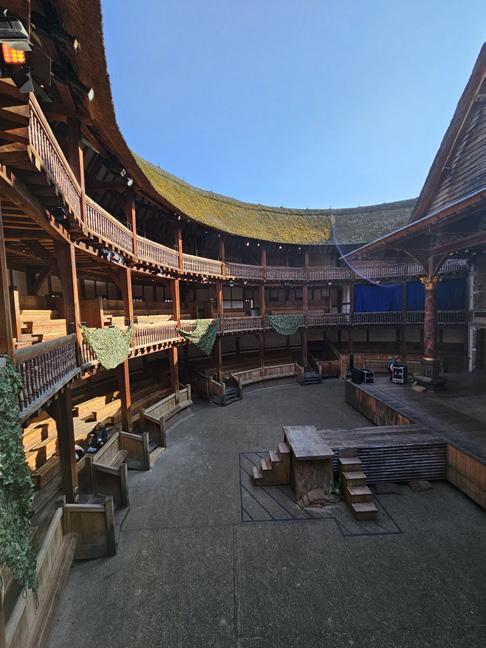
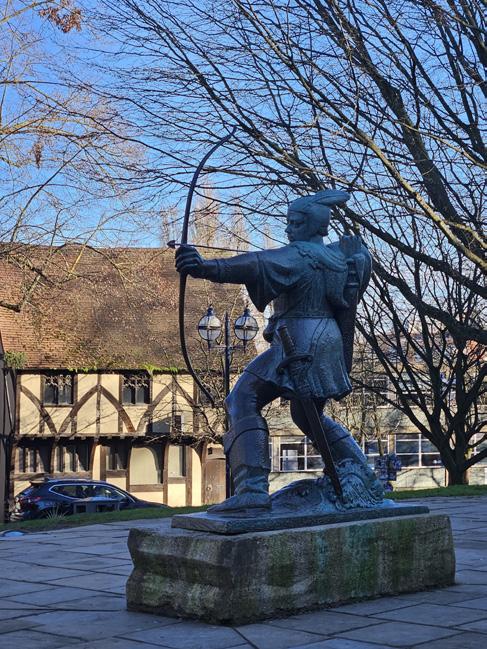
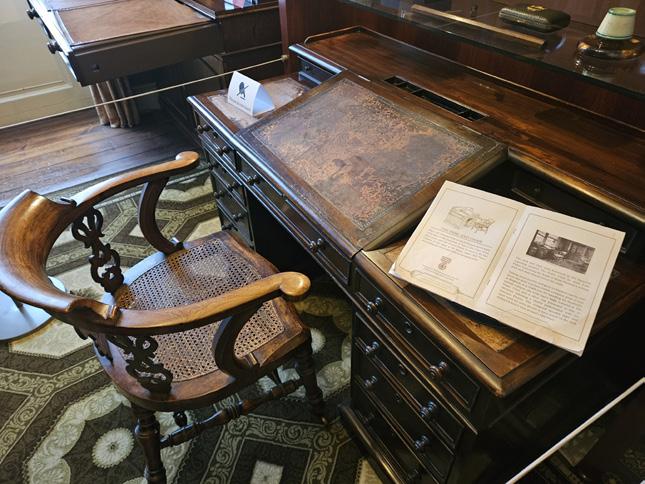

J.K. Rowling: Durham Cathedral, the Shambles, & Kings Cross Station:
The Harry Potter films contain footage from all over the United Kingdom. Several courtyard scenes in the first few films took place in the cloister of Durham Cathedral and Professor McGonagall’s classroom was set up in the cathedral’s chapter house. In the town of York, the twisting cobblestone street called the Shambles feels like a real-life Diagon Alley with shop windows and roofs crowding over the street. Perhaps the easiest Potter destination to reach is Kings Cross Station in London, mentioned or depicted in nearly every book and movie. Visitors to the station can even take their pictures with a trolly that is disappearing into the wall on its way to Platform 9¾.
The small village of Chawton was one of the many homes of Jane Austen, one of England’s most famous authors. Austen fans can visit her large house to learn about the author, see where she wrote and edited her books, and dress up in period outfits! The city of Bath, famous for its beautiful Roman baths and Georgian architecture, also boasts a Jane Austen Center to showcase the author’s time spent in that city. The Jane Austen Center even has its own tea rooms on the top story for visitors wanting to enjoy England’s most famous beverage before or after their visit.


Thirsk, set among the gorgeous Yorkshire Dales, was the home of James Wight (pen name James Herriot). Wight worked as a veterinarian in the small town and its surrounding farms and authored the All Creatures Great and Small books, which have been adapted into several movies and television shows. Wight’s stories about both the comical and serious moments of his career and daily life have delighted readers and viewers around the world. His practice has been converted into a museum with the rooms recreated and redecorated accurately to his time there. In the museum today, visitors to this charming market town can learn all about being a veterinary surgeon in rural England in the mid 20th century.
Road, and Wimpole Street, London:
These places all serve as settings for parts of George Bernard Shaw’s play Pygmalion, as well as its Broadway musical and movie adaptation My Fair Lady. Today, Tottenham Court Road and Wimpole Street do not look like the scenes from the movie, but Covent Garden is still a marketplace. The story’s heroine Eliza Doolittle sold flowers in Covent Garden, which remains a covered shopping district with shops and restaurants of many kinds.

While fans of Mary Poppins might not be able to find 17 Cherry Tree Lane in London today, visitors to the city will likely spot many streets that look very similar to the movie’s sets. One real-life location from the book and movie is the awe-inspiring St. Paul’s Cathedral. The setting for the Bird Woman in the Mary Poppins stories and movie, the cathedral boasts beautiful art and grand architecture both inside and out. Attending one of the church’s many communion or prayer services allows visitors to skip the line and admission fee for the site while also experiencing the Cathedral’s tradition of worship.
The Ashdown Forest in southern England is the original Hundred Acre Wood from A.A. Milne’s Winnie the Pooh books and the Disney movies that were inspired by them. The beautiful forest has hiking paths to the sites of Winnie the Pooh’s, Owl’s, and Piglet’s houses and the Pooh Sticks Bridge. It is a beautiful place to explore the English countryside; just keep a sharp look out for Heffalumps and Woozles! Nearby, Pooh Corner houses a combined gift shop, museum, and tearoom all themed around Winnie the Pooh and his friends.


Two years ago, in 2023, I was presented with a once in a lifetime opportunity: the chance to portray my favorite childhood book heroine in a play and help adapt the script. Little Women is my all-time favorite book and has been since I was in the fourth grade. Jo March instantly became my favorite character ever. I felt that she was exactly like me, even though I was only nine or ten-yearsold. As I grew up and reread the book, watching the various movie adaptations, I saw myself more and more in Jo. I was an aspiring writer. In high school I wrote and directed a play, just like Jo did with her sisters. All of this is to say that when I was cast as Jo in an original theater production with a local theater company, I was ecstatic. I had done plays with this theater company before and they knew I had experience with writing a play, so they also asked me to help finish the adapting of the script. It was a dream come true.
I worked with the three original adaptors. The scenes I worked mostly on had to do with Jo when she was in New York, and I reworked a lot of the scenes that centered on Beth March. Beth is also a special character to me. She reminds me of a childhood friend of mine who passed away from cancer in high school. My friend was not shy like Beth, but she cared for others like Beth did. I wanted Beth to shine in our script and I wanted her (spoiler) death scene to be an impactful moment that slowed down the pacing of the show. The biggest lesson I learned when adapting that scene was that sometimes you have to stray away from the source material. In the book, Beth’s death scene involves just Beth and Jo, but I wanted the scene to have more characters involved. I gave a significant role to Marmee in that scene to better portray a mother losing her daughter. Personally, I think that scene is some of my best work.


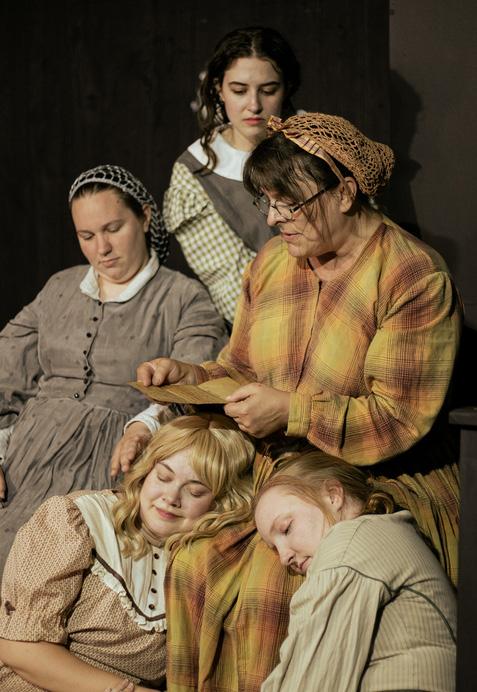

Working on the script helped me understand the nuances of the book so much better and I felt so much more connected to the script than I had with any other production I had worked on as an actress. We started the show when the characters were older and Jo was already in New York trying to sell her stories. We continued through act one with the older versions of the characters until we reached Beth’s death scene. We then diverted from the book again and didn’t have Jo write “My Beth.” Instead, we had her start writing Little Women itself. This is something that a lot of versions of Little Women do. As Jo, I started reciting and pretending to write the descriptions of the four sisters from the first chapter of the book, and as each sister’s name was called, they appeared onstage as their younger self. When the description about Jo was being read (via voice over at that point), I swung off the robe I was wearing and flew down the attic stairs and became younger Jo. I can’t describe in enough detail how cool that moment felt.
The rest of the second act continued with the younger versions of the characters until we met back up to where act one started. The rest of the second act consisted of Jo publishing Little Women and the show ended with a sweet moment between Marmee, Jo, Meg, and Amy (with a nod to Beth). It was a long and grueling process to feel like I was doing Jo March justice, but I think the final product was perfect. I remember I had a lot of bruises from rehearsals because I was constantly running around and falling as the energetic, clumsy, and tomboyish younger Jo. I also stayed late at the theater painting the set and acting as

Jo showing off a copy of Little Women to her family.

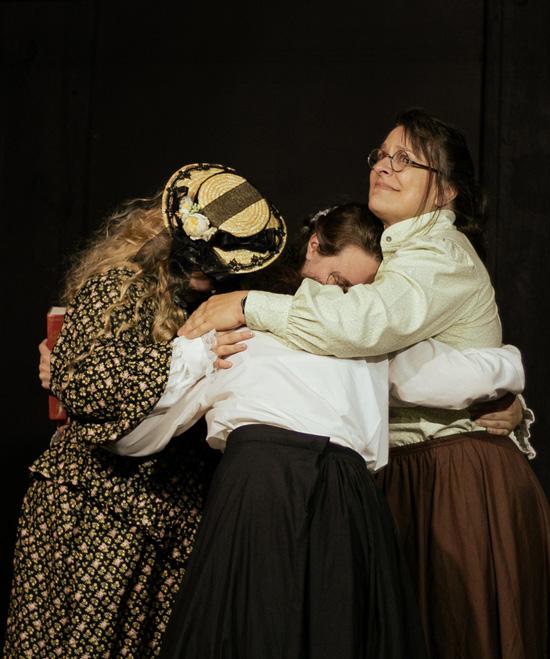
the “assistant to the assistant director.” I had done shows with that theater company before, but I really felt like they had become a second family to me that year. I left my heart on that stage and in that script. I think that remains my greatest accomplishment yet.
All of this to say is that I hope whoever is reading this becomes inspired to achieve their outlandish dreams. Never in a million year did I think I would have the opportunity to do this as a girl from a small rural community, and yet I did.
I also hope this inspires whoever is reading this to embrace their hobbies even if they don’t align with their career goals.
I’m a nursing major, which has absolutely nothing to do with playwriting or acting! Don’t let yourself be put into a box. We can all have passions in life that are not our main careers. As for me, I have taken a slight break from theater to focus on school, but I did get to reprise my stint as Jo for two scenes for the Christmas Variety Show that theater company put on last year. I also hope to return to the stage in a bigger way soon!
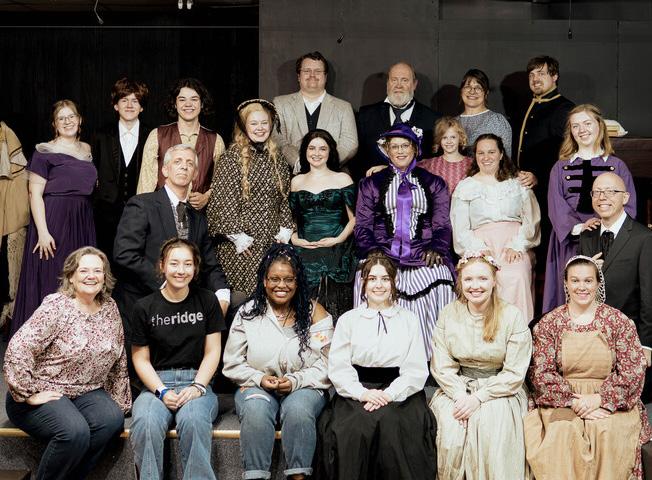
Jess Willsey
In recent years, there has been an ongoing debate about whether more people are becoming sports fans, and the evidence suggests that, to some extent, they are. The rise of digital media, social networks, and global events has significantly increased access to sports, making it easier for people to follow their favorite teams, athletes, and competitions. This increased accessibility is one of the key factors driving the growth in sports fandom.
Streaming services and social media platforms have helped bring sports to a global audience, allowing fans to watch games, catch highlights, and keep up with the latest news from pretty much anywhere. Big sports leagues like the NBA, NFL, and FIFA have taken full advantage of this shift by creating content specifically for online platforms, drawing in younger, more diverse fanbases. Plus, with the rise of sports betting, especially in the U.S. after recent legal changes, there’s been an added layer of engagement for casual viewers, making games even more exciting to follow.
Social media’s role in all of this can’t be ignored. It has allowed athletes to connect with their fans in ways that weren’t possible before, giving fans a more personal stake in their favorite players’ successes. Platforms like X, Instagram, and TikTok have made it easier for fans to feel closer to their idols, which helps build stronger emotional ties to the sport. And with viral moments and highlight reels making their way into our feeds, even people who don’t usually follow certain teams or events can easily engage with the action.
Still, the big question is whether these new fans will stick around for the long haul or just remain casual observers.
While the global sports audience is definitely growing, it remains to be seen whether this surge will translate into lasting fandom. Time will tell if the rise in sports interest will lead to a long-term increase in passionate, lifelong fans.
Why be a sports fan? Being a sports fan comes with a lot of perks: a sense of community, excitement, and a personal connection to something bigger than yourself. It brings people together, creating bonds between those who share the same love for a team or athlete. The thrill of cheering on a team, celebrating wins, and riding out the tough losses creates a sense of belonging. Sports also offer an escape, letting fans take a break from everyday life and experience a rollercoaster of emotions in an enjoyable way. Plus, being a fan can inspire people to stay active, embrace healthy competition, and take pride in supporting their favorite teams.
In the end, the rise of digital media, social platforms, and the growing accessibility of sports have undoubtedly expanded the global fanbase. While it’s still unclear whether these new fans will stay engaged in the long run, it is clear that sports have become more integrated into everyday life. Whether you’re a lifelong supporter or a casual viewer, being a sports fan offers a unique way to connect, celebrate, and enjoy the highs and lows of competition. As the world of sports continues to evolve, it’s safe to say that fandom is here to stay.
So, whether you’re just getting started or already cheering from the sidelines, dive deeper into the world of sports, join the conversation, follow your favorite teams, and get involved in the excitement. Who knows? You might just discover a passion that lasts a lifetime.


Tommy J Housman
Recently, international students across the U.S. have been shaken by an unprecedented wave of visa revocations. As of April 2025, over 600 international students and recent graduates have had their visas revoked or legal status changed by the U.S. State Department. These actions have affected individuals across more than 100 colleges and universities nationwide, often without warning or clear reason. Government officials claim these students were troublemakers—one even labeled them “lunatics” bent on causing campus chaos. In truth, many visa revocations appear tied to peaceful activism and trivial missteps. Some students had their status stripped after participating in lawful campus protests (for example, demonstrations against the war in Gaza), while others lost their visas over minor issues like years-old traffic violations that courts had dismissed.
The human toll of this crackdown is profound. One international student discovered her visa was canceled as she lay in a hospital bed after giving birth. Another student was jailed in a detention center for driving with an expired license. In Michigan, students weren’t even notified by immigration authorities – they learned their status was terminated only when their universities saw it in a database. No chance to respond. No due process. It’s no surprise that “palpable fear” now hangs over international students on campuses nationwide. Many are asking: Could speaking out or a small mistake cost me my education and future?
This draconian campaign strikes at the heart of American academic life and values. Our campuses thrive on free expression and global exchange. International students, scholars, and staff enrich our classrooms and communities. Targeting them for their speech or harmless errors doesn’t just harm those individuals – it poisons the environment for everyone. When visa holders are forced into silence out of fear, academic freedom and open dialogue suffer. When our friends and colleagues worry that any misstep could bring exile, our community’s trust and well-being erode.
Most importantly, these actions undermine fundamental rights. The U.S. Constitution protects everyone on American soil – citizens and visa holders alike. The First Amendment guarantees the right to speak, protest, and associate peacefully without government reprisal. The Fifth Amendment guarantees due process and the right not to incriminate oneself. Revoking a student’s visa as punishment for joining a protest or due to an unproven accusation flies in the face of these principles. No government agency should be above the law, and no student should be deprived of their education and dignity without a fair process. As the ACLU has argued in court, yanking visas in secret – with no notice or hearing – blatantly violates due process rights.
Campus communities are rallying to respond. Legal challenges are mounting. Civil rights groups and
attorneys are fighting to reinstate unjustly terminated visas, calling this crackdown what it is – unlawful government overreach. Meanwhile, student organizations, faculty, and university leaders are speaking out in solidarity. They recognize that an attack on the rights of any community member is an attack on all of us. We cannot allow fear to isolate our international peers. Instead, we must come together— domestic and international students, faculty, and staff—to demand justice and protect each other.
What does that mean in practice? It means refusing to let our classmates be used as political scapegoats. It means pressuring our institutions and elected officials to uphold the ideals of academia and due process. And critically, it means equipping everyone with knowledge and a plan. Knowing your rights can prevent panic and empower action if authorities show up on campus or if a visa suddenly gets revoked. Standing together and being prepared are our best defenses against unjust enforcement.
Following, is a concise Know-Your-Rights and Action Toolkit for international students, scholars, and allies. This guide focuses on protecting First and Fifth Amendment rights, and on concrete steps to build campus solidarity and rapid response. By educating ourselves and staying united, we can push back against fear and injustice—and ensure our campus remains a place where every voice can be heard without jeopardizing one’s future.
Freedom of Expression (First Amendment): You have the right to speak your mind. In the United States, international students, faculty, and staff enjoy First Amendment protections, just like citizens. You can participate in peaceful protests, rallies, and advocacy without fear of lawful punishment for your views. The government cannot legally target or deport you solely for your speech or beliefs. For example, attending a lawful campus demonstration or posting your opinions on social media is protected activity –these alone do not justify any official retaliation. Always remain nonviolent and follow campus rules but remember: your voice is your right.
to
(Fifth Amendment): You do not have to answer questions from immigration or police without a lawyer. If an Immigration officials and Customs Enforcement (ICE) agent or police officer stops you – on campus or off –you have the right to remain silent. You do not have to discuss your immigration status, nationality, political activities, or anything else. It’s wise to provide your student ID or state ID if asked, and you may calmly ask, “Am I free to go?” If they say yes, walk away. If you are detained (not free to leave), you can continue to refuse to answer questions. Politely say: “I am exercising my right to remain silent.” This protects you from unintentionally giving information that could be misused. Do not sign any documents without legal counsel. Even if officers pressure you, you can insist on speaking with an attorney first.
to Legal Counsel and Due Process: You have the right to a fair process. If the government moves to terminate your visa or start deportation, you have the right to legal representation and a hearing in most cases. Contact an attorney immediately (see resources at the end) – you are allowed to have a lawyer at your own expense for any immigration proceedings. Due process means the government should give you notice and an opportunity to respond before
taking serious action like revoking your visa status. In practice, officials may try to bypass this, as we’ve seen – but that itself can become a legal defense for you. If you receive any email or notice that your SEVIS record (student visa record) was terminated, do not panic. You typically have a short window to contest or clarify any error. Save all communications and seek legal help immediately. Remember, you are entitled to fair treatment under the law; being on a student visa does not strip away all your rights.
and Campus Safety: Your dorm is your home – you don’t have to let ICE in without a warrant. On campus, know your school’s policies regarding ICE or law enforcement access. Many colleges treat dormitories as private residences. This means agents need a judicial warrant (signed by a judge) to enter without permission. If an agent comes to your door, you can speak through the door and ask them to slide any warrant under it. Do not open up unless you see a valid warrant. If you’re unsure, you can refuse entry and say your attorney will be in touch. Also, campus police and administrators do not have the right to give ICE information about your whereabouts or schedule without legal requirements – many schools strive to protect student privacy. It’s a good idea to memorize or keep handy an emergency phone number of someone you trust (or an attorney) to call in case of any enforcement action. Being informed about your rights to privacy and counsel can prevent intimidation.
Our entire campus can take steps to respond quickly and stand in solidarity when international students and scholars are threatened. Here are key action items for students, faculty, and allies to implement:
• Rapid Legal Response: Be ready to lawyer up. Form a rapid response team on campus – this could include sympathetic faculty, the student legal aid office, or local immigration attorneys willing to help. Its purpose is to act immediately if a student or scholar
is detained or faces a sudden visa revocation. Speed matters: if someone is taken by ICE or loses status, contact a lawyer and advocacy groups at once to file appeals or injunctions (as was done in Michigan). Have a phone tree or text alert system so friends can quickly share news of any enforcement action and mobilize help. Even a few hours headsup can make a difference in preventing detention or deportation. Plan now, so you’re not scrambling later.
• “Red Card” Know-Your-Rights Training: Empower everyone with knowledge. Host know-your-rights workshops for international students and campus groups. Many immigrantrights organizations offer “Red Cards” – small cards that plainly state your rights and can be handed to an officer to assert your right to remain silent and to refuse a search. Distribute these Red Cards widely (in dorm welcome packets, at international student orientations, etc.). Practice scenarios. For instance, what to do if ICE agents come to a campus event or someone gets a knock at their apartment door. These trainings should also involve U.S. citizen allies, so they know how to support (for example, witnessing an interaction, recording with permission, or simply being present as support). When people know their rights and rehearse their response, panic gives way to empowerment. Make sure every international student, scholar, and staff member knows they are not alone and have rights that the campus community will help uphold.
• Campus Solidarity & Ally Support: There is strength in numbers on campus. Cultivate a culture where international students feel safe and supported. Allies should step up visibly. This can mean organizing solidarity rallies or speak-outs affirming that your school stands with international students against unfair targeting. Encourage student governments and faculty senates to pass resolutions of support and urge the administration to prioritize students’ safety. Buddy systems can help – for example, domestic students or faculty can volunteer to accompany international students to any potentially sensitive meetings or even just check in regularly. If an incident occurs (like a student picked up by ICE), mobilize
a public response: petitions, campus press coverage, and contacting local officials to demand the student’s release and return. A loud, united response can deter abusive treatment. Let those affected know the campus has their back – no one fights alone.
• Push for Protective Campus Policies: Make the institution a shield, not a conduit. Advocate for your college or university to adopt policies that protect international community members. This might include designating the school as a “sanctuary campus” (limiting cooperation with immigration enforcement absent legal compulsion), refusing to share student information (like class schedules or addresses) with federal agents without a court order, and providing legal resources to affected students. University leadership should also be urged to demand answers from federal authorities – for instance, insisting on clarity when a student’s visa is revoked and pushing back against terminations without due process. Schools can coordinate with national education associations to lobby for policy changes. By making it clear that the institution will exhaust every option to defend its students, we both protect individuals and pressure the government to rethink its tactics. Policy change can be slow, but unified voices from major universities carry weight –and in the meantime, strong campus policies create a safer haven.
• Resist and Document Unjust Enforcement: Shine a light on abuses. If immigration enforcement does come to campus unjustly, resist normalization. This means document everything: take notes or video (at a safe distance and without interfering) of any incidents of intimidation, rights violations, or questionable agent behavior. Encourage witnesses to come forward and speak to the press or legal investigators. Publicize patterns of unjust revocations or harassment (while respecting students’ privacy as needed). For example, if several students in one department lost visas after attending a protest, that story needs to be told. Use student newspapers, campus radio, and social media to raise awareness. The goal is to make sure clandestine or unjust actions cannot stay in the
shadows. Public pressure and media attention can stop a deportation or at least rally widespread support. On a broader level, keep linking up with national movements resisting xenophobia and anti-immigrant crackdowns. Campus activism has a proud history of fueling social change – that tradition must continue now, to oppose what is essentially a politicized purge of international students. By refusing to be silent and compiling evidence of injustice, we strengthen legal challenges and uphold our community’s moral conscience.
You are not alone. Numerous organizations across the country are working to defend the rights of international students and scholars. Keep these key resources on hand and don’t hesitate to reach out to them for guidance, legal help, or training materials:
• American Civil Liberties Union (ACLU) – Immigrants’ Rights Project: The ACLU provides legal assistance and “Know Your Rights” materials for non-citizens. They have challenged the visa revocations in court (e.g. ACLU of Michigan’s lawsuit) and can often connect students to emergency legal counsel. Their website offers clear guides on rights during protests and encounters with law enforcement.
• National Immigration Law Center (NILC): NILC specializes in defending and advancing the rights of low-income immigrants, including students. They offer resources on immigrant students’ rights, policy updates, and advocacy toolkits. NILC often works on national policy advocacy, such as, pushing back against harmful immigration regulations that affect students. They can be a source of expert advice on your legal options and have guides for educators and campuses as well.
• Immigrant Legal Resource Center (ILRC): ILRC produces the popular “Red Cards” and Know-Your-Rights materials in many languages. They offer practical guidance on what to do in case of ICE encounters. Campuses can request ILRC’s materials or trainings to better
prepare their international populations. The ILRC’s resources are designed to be easily understandable – perfect for distributing to students and their families so everyone knows how to assert their rights.
• National Lawyers Guild (NLG) –Immigration and Campus Chapters: The NLG is a network of progressive lawyers, law students, and legal workers. Many NLG chapters do legal observer training for protests and offer direct support to immigrants facing deportation. On some campuses, NLG student chapters can help liaise with volunteer immigration attorneys. They also run a National Immigration Project that has hotlines and resources for urgent immigration crises. NLG lawyers are often willing to step in pro bono for urgent cases of detention or First Amendment violations.
Remember: if you or someone you know is affected by a visa cancellation or enforcement action, seek legal help immediately – do not navigate it alone. Connect with one of the organizations above or a trusted immigration attorney. Even in moments of crisis, you have allies ready to fight for you.
Education should never be a weapon of political retribution. By knowing our rights and taking collective action, we can resist injustice and make our universities true sanctuaries of learning and freedom for all.
In the face of fear, we choose to fight back – arm in arm, in solidarity unshaken. Our international classmates and colleagues enrich our lives every day; now it’s our turn to ensure they can continue to do so without fear. Together, we will ensure that liberty and justice on campus are more than just words – they are our lived reality.

Heidi McCombs
Okay, so maybe that title was a little dramatic… but the modern music world is so different from the ones that existed ten, twenty, and fifty years ago. Like anything on Earth, progress of this caliber comes with its pros and cons. We are moving forward, but in that process we are forced to leave things behind.
On the plus side, streaming makes music more accessible than ever before, allowing millions of listeners to hear a new song as it’s released rather than needing to wait for a physical copy or spend money on a digital download. While some music streaming platforms do require a subscription cost, that price usually works itself out to be much lower than paying for each individual song or album would be.
Small artists can pick up traction thanks to social media – gone are the days of needing music industry “connections” to have a song that turns heads. Streaming also offers an extremely personalized experience from music recommendations to messages and special merchandise directly from the artists themselves. We have nearly every song we could ever want to hear, right at our fingertips, right in our pockets.
However, the “age of the algorithm” has certainly come with its negatives. Physical media and digital sales have been on the decline since the emergence of streaming, meaning that artists must rely on most of their money coming from lesser physical media sales alongside merchandise and touring. Streaming does provide some income, but it definitely accounts for a much smaller portion than the others mentioned. Many platforms pay artists very little per stream, some even fractions of a cent. While physical releases are definitely making their comeback (particularly in the case of vinyl records), they are nowhere near as popular as they were before streaming. Vinyl can be expensive to press, especially for smaller artists, and the longer production time also requires a dedicated fanbase who will be willing to not only wait for but also to buy the
release. Digital sales being near defunct means that, because we aren’t spending as much money on the album, we are inclined to be less appreciative of the songs on it. With streaming subscriptions, there are literally infinite amounts of music to listen to, so why would we waste our time with a single album? Why wouldn’t we shuffle playlists or skip to the songs we like? Why wouldn’t we put our trust in the almighty algorithm that feeds us things it thinks we’ll like on a silver spoon?
The aforementioned algorithm (and honestly, today’s music industry as a whole) pushes artists to release lots of singles or shorter EPs rather than full-length albums. Art becomes “content” to be churned out into a million TikToks, Instagram posts, and the latest trends. The process of creating a collection of songs is rushed – the goal is no longer a cohesive piece of work but rather the musical equivalent of throwing spaghetti at the wall to see what sticks (AKA what becomes a trend or garners the most streams).
Social media is the number one place that music is marketed nowadays, so artists — especially smaller or independent artists — may feel the need to include their latest single or upcoming song in every post they make in order to build excitement or keep people’s interest. I don’t know how many Instagram posts I’ve seen “antidepressants” attached to or how many Allison Ponthier TikToks I’ve seen that are set to “Karaoke Queen.” I love them both, and of course there’s nothing wrong with promoting your art. But… sometimes it gets to a point that almost makes you sick of hearing the song you once loved, all while simply trying to support the artist. This push for “content” over “art” also seems to rush the process of an album’s creation. The end goal becomes quantity over quality rather than a time capsule of the band’s sound and lyricism at the time of an album’s release.
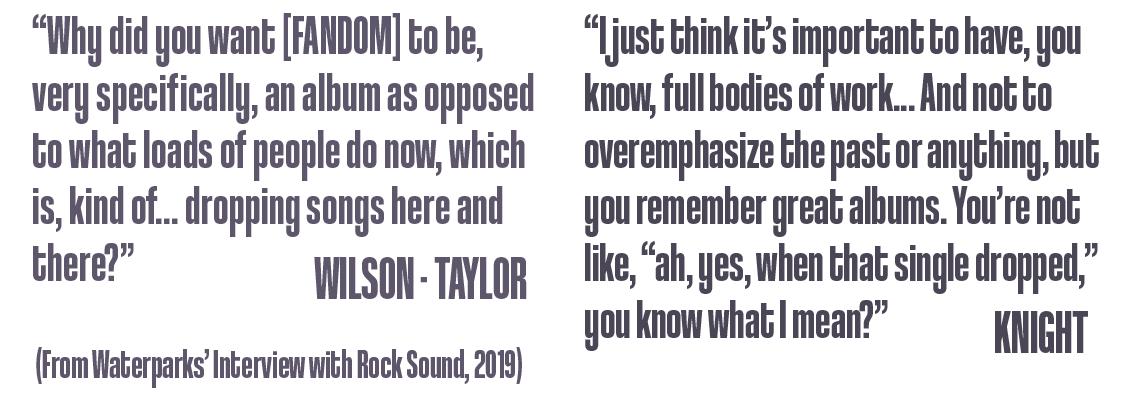
The concept of the album (defined as a collection of songs with seven or more songs) is especially important when it comes to albums with a cohesive storyline, concept, or circularity (Pink Floyd’s The Wall; My Chemical Romance’s Danger Days: The True Lives of the Fabulous Killjoys; Waterparks’ Greatest Hits; Tyler, the Creator’s Chromakopia; and a million more there’s just not room in this article for). Regardless, it’s important to listen to any album in order, no matter if it tells a story or not. The track-list you have in your hands was probably rearranged at least three dozen times to get to where it stands now, meaning that the people who worked on it chose this arrangement for a reason. Maybe that’s because one song leads into another, or maybe that’s really just where it landed after all the others were placed, but either way, track six is track six and not track seven or three or twelve. Shuffling a brand-new album is practically sacrilegious. And anyway, hearing one song fade into the next for the first time (like “NOID” and “Rah Tah Tah” on Chromakopia) is a whole new kind of high that you just won’t get on shuffle.
So often, we tend to give an album one chance to make a first impression. On our first listen, we recognize the tracks we might have heard as singles or the ones that went viral, we start to form the scaffolding for which ones are going into the regular rotation, or maybe they shoot right to your current favorites playlist. If it doesn’t immediately WOW us, we tend to toss it out. Most of the time, we don’t even give it enough time for us to learn the lyrics, to dig deeper into the substance and the message of what we are hearing. Now, of course, there is no one “right” way to listen to an album, but as a self-proclaimed person-who-talks-too-muchabout-music, here are some of my personal tips on how to appreciate an album in its entirety.
This may be divisive, but I’m of the opinion that you should sit down to listen to a new album when you really have the time for it. Yes, you’ve been waiting for this album, and yes, your best friend is already blowing up your phone asking what you think about it. But really, I promise that waiting until you can really sit down to listen to the album in full will allow you the extra brain-power to think about it and appreciate it. If the album is 48 minutes long and you have to be at work in thirty, leave it until you get off, even if your drive will be long enough to finish the album before you clock in.
Another thing to consider might be the time of day when you are listening to the album. Our world moves so fast that we feel like, if we are

night owl, falling asleep during your first listen is counterproductive. Even if you’re exploring an older album for the first time, it’s best to find a time that you are totally able to appreciate it, be it early in the morning or late at night.
I’m a complete night owl, so I usually do listen to new albums when they drop simply because it’s the time when I feel most alert. When it comes to older albums, though, I tend to listen in the afternoons or evenings when I don’t have a lot of other work to do. Something about the hazy in-between-ness feels right for these works that I’m hearing pretty late in the game.
Find somewhere quiet to listen to your album, someplace where you won’t be so distracted that the music fades into the background but also someplace where you won’t feel like you’re in solitary confinement. Listen alone, or at the very least make sure your companion is someone who won’t interrupt you much (if at all). Lay flat on your bed, or your floor, or curl up in your favorite chair, or sprawl out on the deck in a patch of sun. It doesn’t really matter where so long as you’re comfortable and relaxed, ready to absorb the music in its entirety.
You also may want to consider the platform or medium that you want to experience t he album on – Spotify, Apple Music, Youtube, CD, vinyl? These are all rather different from one another, so be sure to choose something that feels familiar for you. If you don’t have access to a streaming service without ads, you might consider finding mp3 files of the songs so that you can hear them without ads sandwiched between the artist’s messages. If you have trouble staying off your phone when using it for music, maybe you could try checking out a physical copy of the album from your local library or borrowing one from a friend.
I usually turn to Spotify for my albums, but on occasion I’ll pick up something that sounds interesting from a thrift store or an online shop and let my secondary listening happen in the
car while I drive to work or dinner or whatever else is on my schedule. I prefer my first listen to not happen in the car because I find that, even on the most peaceful drives, the music becomes static in my overactive brain, but you might find that driving helps you to focus. Again, it’s all subjective here!
Possibly the most important thing about listening to a new album is that you should leave your reservations at the door. Whatever singles you’ve heard, whatever Pitchfork or Rolling Stone review you read, you need to learn to take that off like a muddy pair of shoes. This band, this singer, whoever it is, has crafted this album for you as a piece of artwork to be contemplated, not just as content to be consumed and thrown away. If you go in expecting a repeat of that last album that you really liked, you’re probably going to be disappointed. Almost every group on earth has some album with a bad reputation because people were angry that they wanted to try something new – just look at Twenty One Pilots’ Scaled and Icy (2021) and Fall Out Boy’s MANIA (2018). You love them or you hate them (and I happen to love them, but that’s a whole different can of worms).
Try to listen without distractions, at least for that first time. Listen with headphones, with the music right up against your eardrums, and shiver when you hear the guitarist’s pick scratching the metal strings or the vocalist’s breath catching between lines. It sounds corny, but really listen and try to pinpoint where you feel the sounds in your body. Maybe you feel the bass and the drums in your chest, the guitar in your stomach, the piano in your temples. Maybe you think the music sounds green or blue or like the smell of printer ink – feel that!
If you must do something with your hands, open your notes app or a blank page in your notebook and write down your first impressions. Even if you’re not much of a music critic, it’s always fun to see how your opinions on the songs change or stay the same over time. I’ve had songs that I hated the first time around that ended up on repeat months later. If you’ve
ever heard that “distance makes the heart grow fonder,” I think that phrase can most definitely apply to albums and their distance from release day.
Give it one chance. Then give it another, and another. After the first time, listen to it everywhere – in the car, at work, while you do homework. Splinter it out on playlists, and then remember how much you loved (or hated!) that album and circle back. I’m not telling you to listen to it until your brain melts out of your ears, or to listen until you never want to hear the songs again. But find the ones you like, find the little sounds and slides and breaths in the rest of the songs that make you appreciate their construction.
At the end of the day, how you listen to an album is between you and the artist. I’m not here to tell you the definitive “right way”–no such thing really exists. Maybe your “right way” involves listening to the songs while you hole up with a pan of watercolors or a pack of crayons, maybe it involves picking up the


While you might already be familiar with the term “gender gap” from sports, politics, or the sciences, did you know that a gender gap exists in archaeology as well? In fact, the presence of sexbased discrimination towards female academic archaeologists at colleges and universities in the United States remains a well-known but rarely addressed issue in the archaeological world. As someone whose dream career is to become an academic archaeologist, I felt inspired to research this topic in the fall of 2024. Moreover, two of UE’s archaeology professors have spent significant parts of their careers tackling this issue.
It only takes a quick internet search to see the imbalance among the numbers of men and women who work in American academia. According to the American Association of University Professors (AAUP) and the American Association of University Women (AAUW), 36% of full professors, 44% of tenure-track faculty, and the majority of contingent faculty (lecturers, adjuncts, instructors, etc.) are women. These percentages are nowhere near the goal of 50%. Despite the surge in women attending undergraduate archaeology programs in the US, the current data on the number of women who are archaeologists working specifically in
academia either does not reflect this rise or is extremely scarce. Altogether, this disturbing reality led me to wonder about what obstacles still prevent female archaeologists from equal representation in academia.
The answer is simple, but the solution complex: systemic sexism
I believe the reason that female academic archaeologists still face systemic sexism is because of chauvinism’s persistence in American culture. According to the MerriamWebster Dictionary, chauvinism is “an attitude of superiority towards members of the opposite sex.” Chauvinism in American culture is the pervading view that men are superior to women and therefore deserve better and more opportunities for success. It is precisely this attitude that leads to sexism, and ultimately, misogyny. The continuing effects of systemic sexism in archaeological academia include a gender gap in positions of power, gender bias in publishing, and harmful conditions in the workplace. Fortunately, I have found that North American archaeologists, particularly American Historical Archaeologists, have been more consistent in recognizing and addressing this issue than Classical archaeologists, which provides a source of hope and a path towards promoting change.
First, there are fewer women in positions of power in archaeological academia, which include tenured/tenure-track professorships and directors of field schools. According to the AAUP (2024), across all academic departments in the fall of 2021, men held 65% of tenured and tenure-track positions, while women held 54%. On the other hand, men held 35% of contingent faculty positions, while women held 46%. Using these percentages and approximate counts from a 2012 blog, I calculated that across the US, 759 male archaeologists have tenure or tenuretrack positions versus 631 women, and that there are 215 contingent faculty archaeologists who are women versus 164 men. I predict that the gender gap in the numbers of contingent faculty will only increase as universities turn to hiring more and more adjunct faculty to
save money. The situation in Classical archaeology is especially severe; for example, it only took until this academic year for the UE Archaeology Department to have an even 50/50 split between male and female faculty, despite consistently accepting more undergraduate students who are women. Additionally, fewer female archaeologists are hired as field school directors; the director of the field school that I attended in the summer of 2023, Poggio Civitate Archaeological Project, was a man, while 62% of the staff under him were women.
A gender bias against women in academic archaeological publishing has been a problem since the time of former UE professor Mary Ross Ellingson, whose graduate school advisor ultimately plagiarized her master’s thesis in the 1930s. It is this specter of plagiarism that continues to haunt modern academic publishing, because the same chauvinist ideas that motivated Ellingson’s advisor still exist, albeit in a different form. Even today, fewer women are published than men in both North American and Classical archaeology; however, more North American archaeologists, such as Dr. Laura Heath-Stout, have published peer-reviewed articles with evidence supporting the gender bias than Classical archaeologists.
For example, Heath-Stout found that, from 2007 to 2016, men wrote 58% of the articles in the Classical American Journal of Archaeology, while women wrote 42%. Men wrote 69% of the articles in the North American Advances in Archaeological Practice; women wrote only 31%.
Unfortunately, female academic archaeologists also continue to experience a range of sexist behaviors from their male colleagues in the workplace, from comments on teaching evaluations, to rigid gender roles, and even sexual harassment. According to Kim Elsesser in a 2024 Forbes article, “Female faculty… receive lower numeric scores and more negative comments about their personality, appearance, competence, and professionalism” on evaluations than their male colleagues. It is often female faculty that face society pressures to “chose” between having a family or having a career. Furthermore, blogs such as Trowelblazers, podcasts such as Women in Archaeology, and other forms of popular media have recently become safe spaces for women in archaeological academia to share experiences of inappropriate and violent sexist behavior from their male co-workers in the field that other men have often downplayed as “funny” or “harmless.” Once again, it is female North American archaeologists, like the creates of Trowelblazers and Women
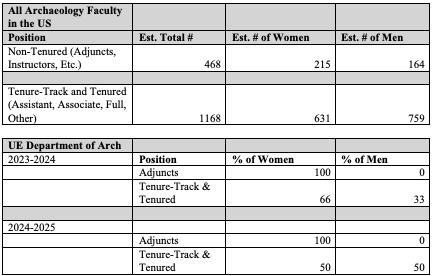
in Archaeology who have led the way in alerting the public to the harm that women have experienced in their workplaces.
Why is addressing systemic sexism in American academic archaeology so important? Women in positions of power provide unique perspectives that deserve to be heard equally and they provide important mentoring roles in a discipline that is quickly becoming female-dominant. Controlling the dissemination of one’s own work is also very empowering, and as readers hear the voices of more published women in archaeological interpretation, it will loosen men’s dominance over how the public learns about archaeological sites. Finally, women deserve to feel safe and respected in a job that they love. So, what can we do about the gender gap in archaeological academia?
Currently, I am looking more into why North American archaeologists addressed and criticized systemic sexism in the discipline earlier than Classical archaeologists. So far, I have found that North American archaeology has tended to be more diverse, more self-critical, and more open to new ideas than Classical archaeology. For far too long, Classical archaeologists have been more focused on “proving” events in famous ancient texts and conducting large digs than reflecting on the need for change in their discipline. I believe that there are many strategies for combating sexism that Classical archaeologists can learn from the initiatives of North American archaeologists. I also think that holding men accountable for their inappropriate behavior, and implementing diversity policies in hiring academics, are also good places to start.
Most importantly, however, it is vital to recognize that real change relies on altering the dominant chauvinist culture, and cultural change is far more difficult. This type of change really begins with students like me and you, who must remain willing to write, speak, and present on systemic sexism, because our work sets an important precedent and leaves behind an “action plan” for future generations to follow.
In order to provide equal oportunity learning, Disability services works with students and faculty alike in order to provide necessary accomidations for students to thrive on campus. Accomdations provided are dependant on the nature of the disability. Open 8am and 5pm
Counseling services is there to help with your mental state. Even if it is something that has just occurred recently, they are there to help you through it.
Looking for a place to make a change? The Changelab looks to create a more just, prosperous, and sustainable world. All Changelab courses on campus are overseen by this center. However, where they meet varies by class.
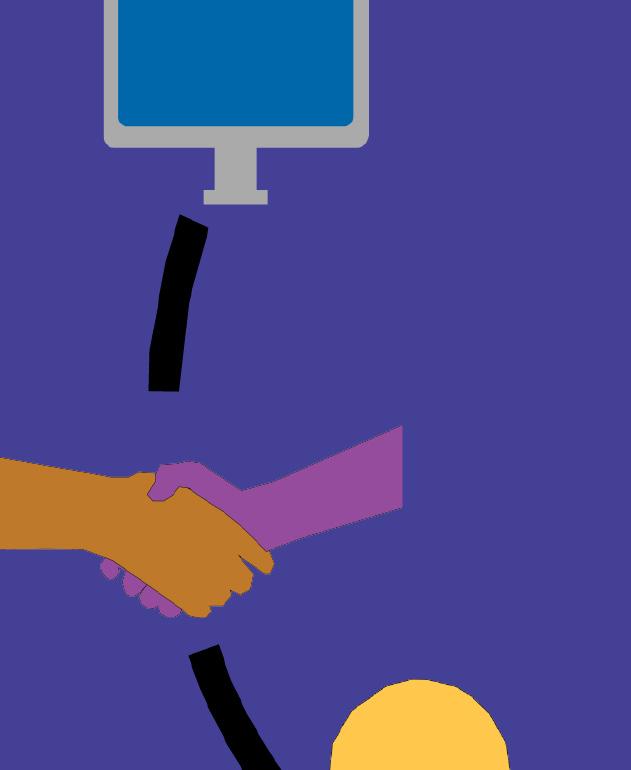
Office:Upstairs Ridgeway
Phone:812-488-2663
Debbie Brenton:db132@evansville.edu
8am and 5pm
Office:Upstairs Ridgeway
Phone: 812-488-2663
Email: counselingservices@ evansville.edu
8am and 4pm
Offices:Ridgeway 270-274
Phone: 812-488-2455
Email: centerforinnovation@ evansville.edu
Design and Innovation Studio
Located in the Tapley Center, this new studio is meant to aid in proffessional and educational development by giving a broad range of students hands on experience with cutting edge technology. This is a good place to get creative. A few things in there include 3d printers, 3d pens, tablets, and sphero bolts.
Open Monday - Thursday between 8am and 8pm along with Friday between 8am and 4pm
Office:Olmstead 234
Phone: 812-488-3802
Email: uerelations@evansville.edu
Whether looking for a job or internship, Career Services can help! They offer assistance with creating resumes and updating existing ones. They also host career fairs and speed networking events throughout the year to give you interview practice and connect you with employers in your field.
The Office of Technology Services’ mission is to empower the campus community through innovative solutions and support by which users will be able to implement and effectively take advantage of new technology.

Open Monday-Friday 8am-5pm
Open Monday-Friday 8am-5pm
Office:Upstairs Ridgeway
Phone: (812) 488-1083
Email:career@evansville.edu
Office: Room 168, Clifford Memorial Library(Entrance across from Olmstead as well between Clifford and Bower) Phone: 812-488-2077
Email:help@evansville.edu
I’ve only been told something that shattered my entire world once in my life, and it came from my psychologist at the end of our very first appointment.
“I am sure you have schizoaffective disorder.”
Schizoaffective disorder is the love child of schizophrenia and bipolar disorder. The affected are blessed with both psychotic and mood symptoms. Hallucinations (audio and visual), delusions, mania, and depression are the symptoms that I happen to experience.
My visual hallucinations vary; sometimes I see monsters while other times I see people. Sometimes, I’m sitting in class and everybody’s head is turned, staring at me with unsettling eyes. I’ve hallucinated trains and even an entire CVS once. However, in my case, audio hallucinations are more common, creating annoying paranoia. I hear footsteps in my home, whispers, my name, doors opening, sirens, etc.
I also get delusional, usually coming






























college, in the summer before junior year. I had known something was wrong for a while, but I never would have guessed that it was this. I felt like the world stopped as she prescribed me anti-psychotics. I knew what this does to people. I knew what my fate was.













hand-in-hand with mania. My brain loves to believe things that aren’t true, ranging from believing I’m God’s equivalent with a higher understanding that everybody else to believing my loved ones are plotting against me.
I was diagnosed exactly halfway through

I started taking the medicine. The dosage was adjusted and mood stabilizers were added until they actually started working. It was amazing, I felt normal for the first time in my life. My morale improved. My grades improved. I went from barely passing classes to barely missing the dean’s list. It felt amazing, until it didn’t. I made the mistake of doing research on schizoaffective disorder out of curiosity.
My life expectancy is about 15 years shorter than yours (assuming you’re an able-body and able-minded individual). This isn’t because of the disorder, it’s because of the probability of what I might do while having it. Fifty percent of individuals with schizoaffective disorder attempt suicide at least once. This scares me.
“When your schizo gets bad, are you just gonna kill yourself?”
one of my best friends asked me while driving us home from a concert. It was a joke, but what if she’s right? What happens when I get worse? Schizoaffective disorder, like most psychotic disorders, get worse as you age. I’m doing okay now, but what happens in ten years? Some people go their whole life just fine and they snap in the blink of an eye and do terrible things. What happens at 30? What happens at 40?
I minored in Legal Studies. We were learning about the insanity defense, when and how it can be used, and examples. We watched a documentary about a man on death row. He had lived a somewhat normal life. He had some ups and downs here and there but was, for the most part, normal. One day, something in him snapped and he killed multiple members of his family. He was diagnosed with schizoaffective disorder in prison.
I didn’t struggle more than the average student, but I did struggle differently. Dealing with the daily battles that come with schizoaffective disorder added to my stress, but this is not where my biggest struggle came from. What good will college do me if I’m destined to succumb?
Schizoaffective people often end up on the streets or incarcerated. I wouldn’t consider myself a pessimist, but this is different. Is this what I have to look forward to? Statistically, maybe. Stereotypically? Absolutely. Why should I waste my time, effort, and money on a degree that might be overshadowed by my disorder? I know how wrong it is to believe that, but sometimes I just don’t care.
I should want to break the stereotype.
I should want to prove society wrong. I should want to be as successful as I can and this should motivate me.
But it doesn’t. I am scared I am not the type of person who has enough drive in their soul to break out of the dark places schizoaffective disorder takes you.
It’s lonely here. Any disorder starting with “schizo” comes with a heavy stigma that I still am not sure I can carry the weight of. I told very few people throughout my four years at the University of Evansville about my struggles and my diagnosis. Only a handful of my close friends know. I am embarrassed of who I am and what I deal with, even if nobody can tell from the outside. I convinced myself that once people found out, nobody would
look at me the same. There’s so few of us, and plenty set a bad example.
I will not be one of them.
I need to remind myself of everything I have already accomplished. I graduated high school and passed two years of college undiagnosed and unmedicated while working over 30 hours a week. I kept my bills paid and my pets fed, and maintained a good relationship with my friends and family. Knowing about my disorder doesn’t change what I’m capable of or dismiss what I’ve already done. Getting diagnosed as schizoaffective doesn’t allow me an excuse to fail, it provided me with the opportunity to understand myself.
I’m finally coming to terms with being schizoaffective. I’m letting myself learn what it means to me, and I’m getting closer to forgiving myself for being this way. I’m slowly understanding that I’m not just a schizo waiting for my inevitable demise because I’m so many things.
I am a strong woman. I am fun to be around. I am a great friend. I am smart, I am resourceful, and I am a soon-to-be college graduate with nothing short of my whole life ahead of me.
I am Bev.
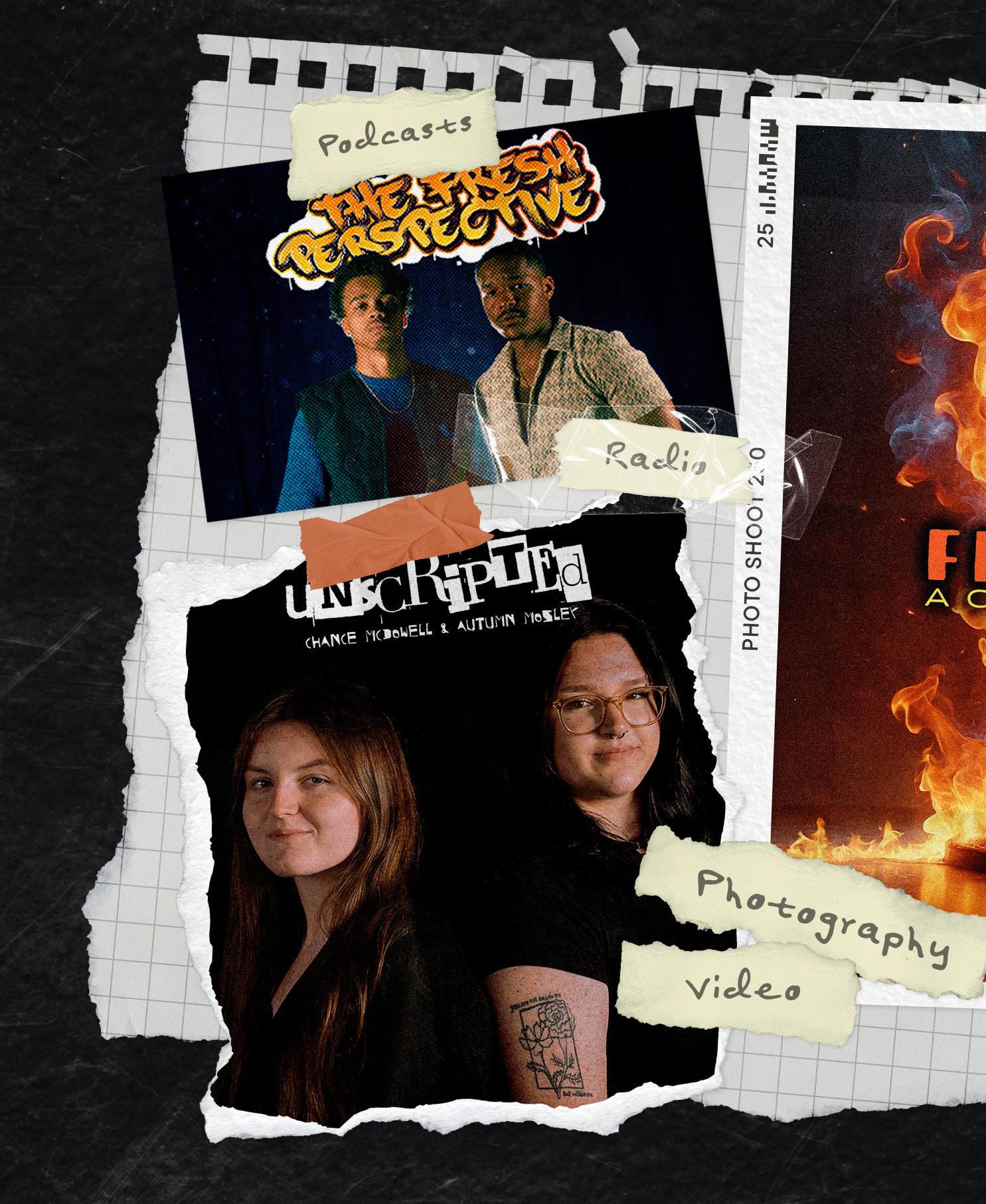



a fair exchange of rare-earth minerals in exchange for the guaranteed continuation of aid. However, Zelensky left the meeting with his country insulted and no deal struck.
Zelensky was met with contemptuous hostility from Vice President JD Vance and President Donald Trump, who repeatedly hammered insulting statements to the visiting president. Trump and Vance repeatedly insulted President Zelensky by interrupting him while he was speaking about political influence. Zelensky tried to state multiple times that the US would feel influenced by the long-term foreign policy effects of the war. Instead of showing respect to another leader, Trump stated that Zelensky “does not
independence goes back four hundred years to the Cossack people (later Ukrainians) who lived in the steppes of Europe. Descended from Kyivan Rus Vikings, these settlements of farmers were concentrated in the same area where modern Ukraine exists today. They felt an attachment to the Crimean Peninsula, the Eurasian steppes, and the Dnieper River. They have endured through the first three hundred years as a minority population in both the Polish-Lithuanian Commonwealth and Austria-Hungary. After the Russian Revolution, Ukraine was able to become an independent state in 1918, only for the Russian SFSR to launch a Bolshevik invasion to occupy the country in early 1919. Ukraine became free again under the liberal policies of Mikhail Gorbachev, which allowed Ukraine to eventually break from the Soviet Union and become a sovereign state.

Devon Mathews
Upon becoming a sovereign state, Ukraine found itself in the position to have a great portion of Russia’s nuclear weapon arsenal along with other postSoviet states. Russia, antagonized by this, demanded that the nuclear products of its Soviet Empire be returned to Russia. These countries, along with the UK and the US, helped broker a deal that successfully returned these weapons to Russia. In return, Ukraine and other post-Soviet states were given several guarantees in the agreement. These guarantees include the recognition of Ukraine’s government and territory, a refrain from the threat or use of force against territories of other states unless it applies to self-defense, a refrain from economic coercion designed to subordinate the Ukrainian state to another’s interest and require the invaded nation to seek aid from the UN Security Council to assist in a conflict in case of a violation. Ukraine signed onto this deal, hoping these guarantees would secure a long-lasting defense for its national security.
In 2014, Russia broke the Budapest Memorandum by initiating the Euromaidan Crisis. The crisis was a mass protest in response to the pro-Russian president’s decision not to build closer ties to the European Union. This sparked mass protests in Russia, which led to Putin’s regime annexing the Crimean Peninsula and the Donbas region in Eastern Ukraine due to the large Russian populations existing in the area. Little was done back then to stop Russia, which has led to a long-term conflict between Ukraine and Novorossiya, a combination rebel state led by pro-Russian militias in Donetsk and Luhansk. The two forces remained in a First World War-like standstill involving trench warfare until a few years ago.
In 2022, Russian troops were spotted amassing along the Ukrainian border via satellite images and reports from
intelligence services. Media across the world began to discuss the potential invasion, at a time when Zelensky invited President Putin to de-escalate the need for military action. However, the invasion of Ukraine began on February 24th with much of Eastern Ukraine being swallowed and encircled by the morecompetent Red Army. The goal was to take Ukraine within two weeks by seizing Kyiv, the capital city of Ukraine. Ukrainian civilians, along with soldiers, subverted the expectation that the locals would welcome and accept liberation from their government. Most Russian soldiers actively believed, and possibly still believe that Ukrainians need to be saved from their own “Nazi” government. The “Denazification” effort, otherwise known as the “Special Military Operation in Ukraine” was Russia’s reason for attacking. Such ideas about Ukrainian identity were formed and circulated within Putin’s centralized media platforms, trapping the Russian people in another reality in which a war against their peaceful neighbor seemed necessary.
Putin’s two-week goal failed due to Ukraine’s strong resistance and Volodymyr Zelensky’s response to the Biden Administration’s invitation to evacuate him. He left the following powerful statement with Biden: “The fight is here; I need ammunition, not a ride!” His contribution gained popularity and shows that he is united with his people. He shows that Ukraine would fight as long and hard as they possibly could for their sovereignty, which is also referenced in the Ukrainian National Anthem: “Ukraine Is Not Dead Yet.” Following the struggle to stay and fight, Ukraine aid and military packages from the U.S., Canada, and most of Europe to assist in their endurance in the war. Everything that Ukraine receives is critical to its national security and stabilization, which is why Zelensky continuously visits other countries to strike deals, gain the favor of foreign governments, and show gratitude
for the continuous aid that has been given and will be given.
Vance’s decision to question Zelensky’s gratitude to the U.S. and demand that Zelensky thank the U.S. again thoroughly demonstrates the lack of decorum in current U.S. foreign policy. President Trump’s decision to insinuate that Zelensky started the war and currently juggles the prospect of World War III is a grotesque inaccuracy that destroys the U.S.’s positive reputation on the world stage. Zelensky is fighting for the lives and freedom of his people, while Trump continuously berates him and talks about “playing cards.” It is utterly humiliating and disappointing that foreign policy under Trump likens the lives of people to cards and treats war like a standard business.

With the beginning of spring comes the first blooms of the season. Flower shops sell their typical potted plants and bags of bulbs fly off the shelves to be planted or hung up to soak in the spring showers. Roses, tulips, and peonies become staples of front porch steps, but what about the flowers already growing in the yard? Or the ones sprouting through cracks in the sidewalk? Each plant contributes uniquely to the world around us, especially those native to the environment. However, with growing concerns over the state of the natural world, it is essential to realize just how crucial these species are for the continued stability of our ecosystem. According to the National Wildlife Federation, native plants are species naturally occurring in an area over a long period without human introduction. In the United States, that generally means plants that grew here before the Europeans arrived. These plants hold relationships with the native wildlife, ones that have been cultivated for thousands of years. The Indiana Native Plant Society reports that Indiana is home to over 2,900 plant species, with only about one-third being non-native. When humans begin introducing non-native and even invasive species, a habitat’s stable ecosystems are thrown upside down.
Native plants, having lived in a single space for thousands of years, are adapted to the local climate and landscape. When gardening, they do not require fertilizer or harmful pesticides because they are used to the basic conditions of their local environment. They’re developed to the water patterns of the area, which makes them require less watering. Considering all this, they are a more sustainable option than non-native plants, which require much more cost and energy.
The local food chains rely on native plants to sustain their surrounding individuals, like insects and animals. Plants photosynthesize light energy to produce sugar molecules and oxygen. Herbivores and insects feed on that, depending on plants for food,
and carnivores, in turn, eat them. Local herbivores are adapted to eat plants that coevolve with them and often will not branch outside of what they know. If there aren’t any native plants, the species living there are at a loss for food.
Biodiversity encapsulates the richness and variety of life on Earth. Each species has a job to do and thrives in a particular niche. Unfortunately, this much-needed facet of life is steadily declining, and has been for years. Changes in biodiversity lead to an unhealthy ecosystem that humans may not be able to rely on. Without a wide range of plants and animals, the Earth cannot provide resources such as water purification, medicine, clean air, and reliable food sources. By planting native species, the diversity that helps the planet thrive is kept in place.
Many modern components harm natural plant communities and, to a more significant extent, the planet. Similarly to endangered animals, plants also suffer from invasive species, habitat loss, urbanization, climate change, and pollution.
As mentioned earlier, the introduction of invasive species is harmful to the natural environment. The Indiana Native Plant Society defines invasive plants as nonnative species that may cause harm to the economy, environment, or human health. These species displace natural ones, eliminate key food sources, and threaten endangered plant species. They often have no predators, leading to overgrowth and potential damage to the ecosystem. The Indiana Department of Natural Resources monitors and fights back against dangerous invasive species, including detailed lists and places to report your sightings. Their 2020 Invasive Species Plan can be found at: https://www.in.gov/dnr/files/fw-terrestrialinvasive-plan-2020.pdf
Cities and towns are losing their green spaces. Wild areas are being cleared to accommodate the demand for housing, industry, and farming. This world-wide issue threatens and destroys global biodiversity. In 2020, the United Nations Environment Programme reported that over the past 30 years, 420 million hectares (1,621,629 square miles) of forest have been lost and converted for other uses, with another 100 million hectares (386,102 square miles) at risk. These losses are devastating and do not bode well for the future of our ecosystem. To combat this, we can support local initiatives to grow natural spaces and native plants and donate to nonprofits that advocate for conservation.
Pollution and climate change have disastrously altered the planet, and relationships in nature are shifting in ways humans cannot keep up with. Traditional temperature and rainfall patterns are unstable, leaving plants unable to cope with such sudden changes. They cannot absorb all the carbon dioxide they need to, leading to more entering the atmosphere and accelerating the planet’s warming. Plastic floats in the ocean and is buried in the soil, clogging up the plant’s natural cycles. Becoming more aware of how humans affect climate change is key to helping stabilize this relationship once again.
Many individuals nationwide passionately advocate for strengthening the natural environment, including many in Indiana. The Indiana Native Plant Society is one of them. On their website, they have plenty of valuable resources for learning more about our environment and finding native plants for your garden. The Indiana Wildlife Federation provides a broader range of information, including details about native animals. They include links on taking action, volunteering, and even resources for creating a more sustainable campus. Supporting organizations like these are essential to preserving the fragile stability of our ecosystem and helping our neighborhoods thrive.
Julian Shellnutt

New England Aster (Symphyotrichum novae-angliae)
The New England Aster is an Evansville native plant that plays an important role in our ecosystem. It’s purple flowers help attract birds and butterflies when it blooms in the fall months.
Native plants help keep our ecosystem functioning by conserving water, creating habitats, cleaning the air, and preventing erosion. Theseenvironmental services are essential to humans and one of the reasons native plants are so important.
You can find New England Aster at the Howell Wetlands and Wesselman Woods. Its large bulbs spout purple petals with a color hard to miss. If you live in Evansville consider planting New England Aster to attract butterflies and other animals.


Hello!! My name is Elijah Hamilton and I was fortunate enough to participate in Journey to Justice, a class we offer here at the University of Evansville. It’s available during spring break and is a great opportunity to learn about the civil rights movement and going to the cities that had the most impact.
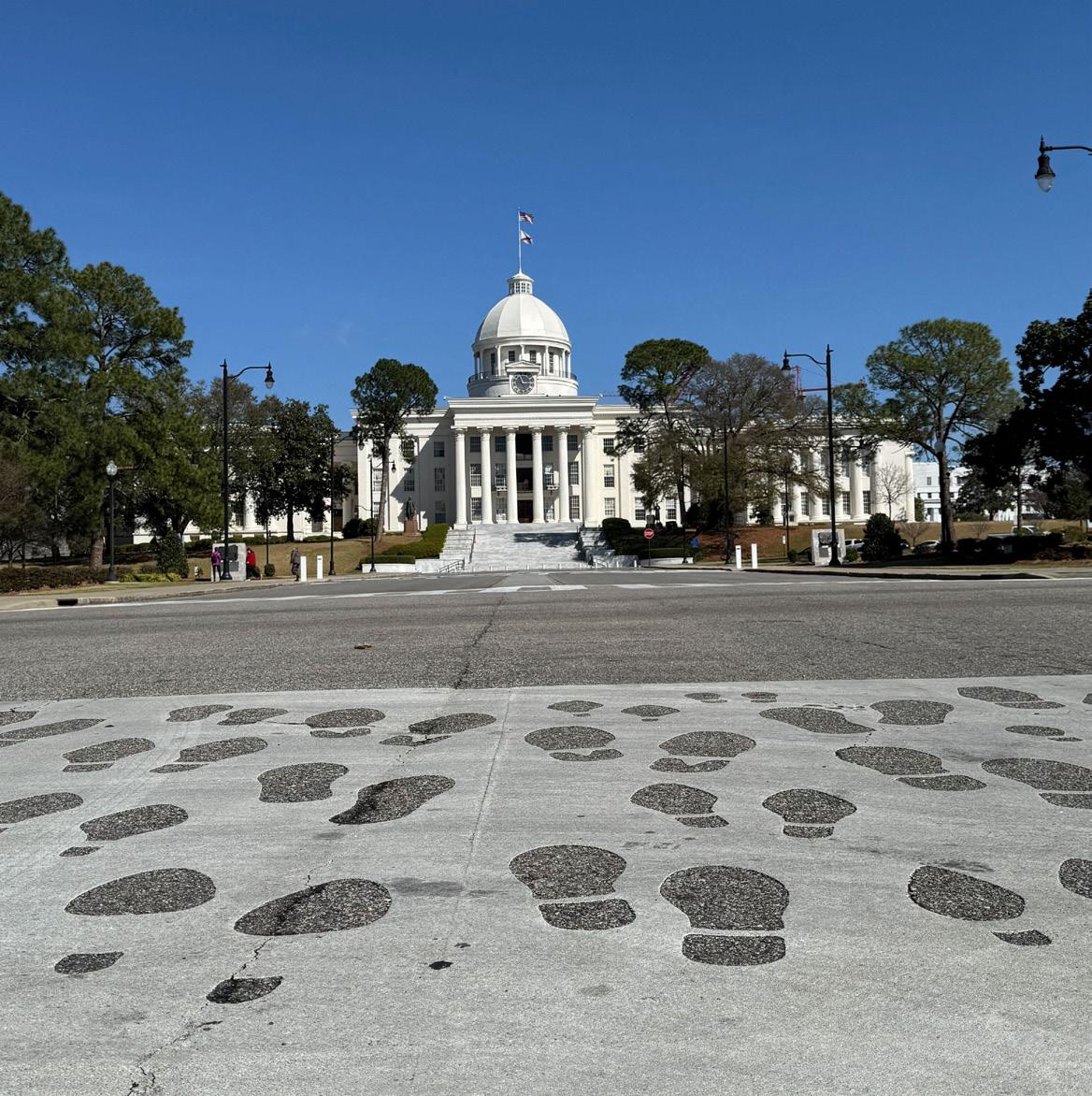
This picture shows the Alabama State Capitol, located in Montgomery, Alabama. In this photo you can see permanent footsteps, representing the physical footsteps as well as the embodiment of the lasting impact of the foot soldiers who marched from Selma to Montgomery. This street is also where Dr. Martin Luther King Jr gave his infamous speech at the conclusion of the march, “Our God is Marching on.”
The Edmund Pettus Bridge is located in Selma, Alabama; although to you it may just look like any old bridge, this bridge actually contains so much history and context within it. This bridge was the site of “Bloody Sunday,” where police brutaliy attacked foot soldiers and threw tear gas at them. The law enforcement came down on the protestors on both horses and by foot and used batons to attack the foot soldiers on the bridge, essentially beating everyone in sight without hesitation and faced no consequences for their actions after the act.

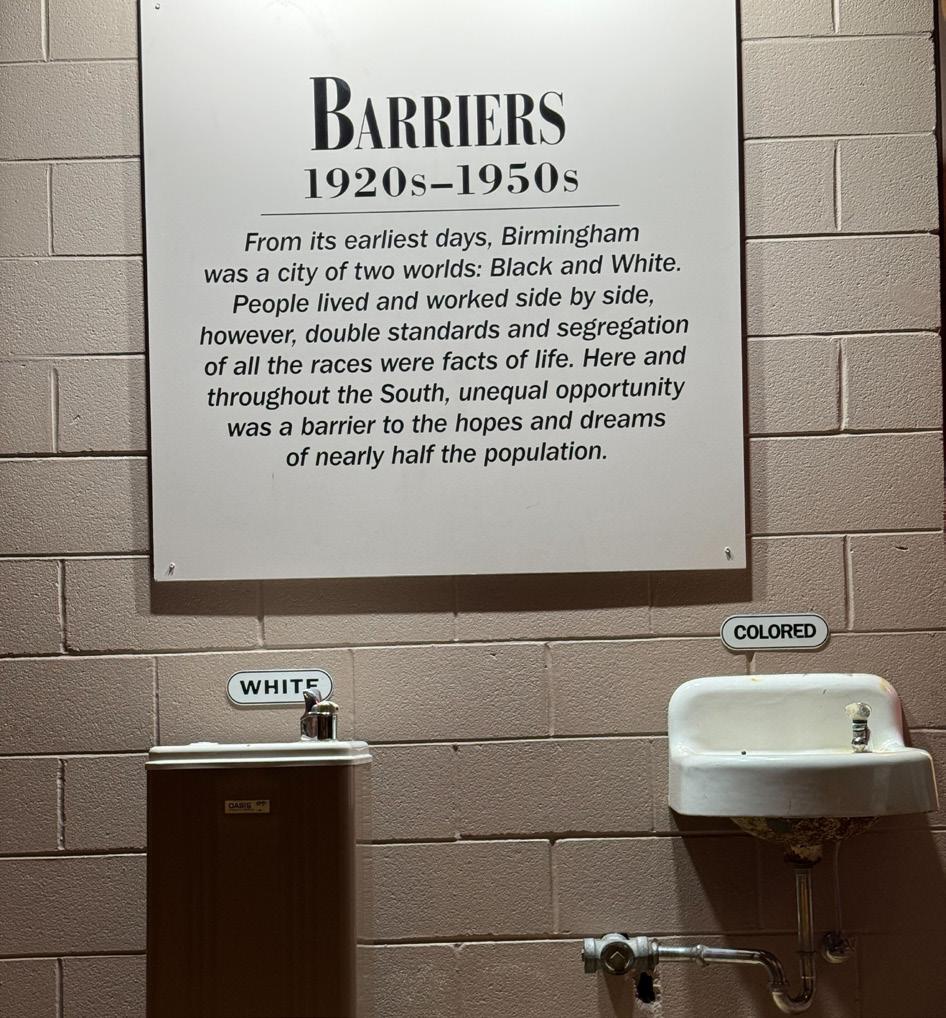
This picture is a representation of the state of this country not even 100 years ago and how “colored” people were forced to be seperated, segregated, othered. While on this trip, I learned that Black Americans had to be separate from the Whites in nearly every public space: riding the bus, watching a movie, and even using the bathroom. Pretty crazy to think about in current society, right?
In Selma, Alabama, you can find this beautiful mural close to Brown Chapel, which was the starting point of the march from Selma to Montgomery. Our group during the trip was fortunate enough to have a woman explain this mural and its importance. She had been a part of the gatherings and meetings for the march, but was too young to participate, as she was around 11 or 12 years old at the time. To summarize how she explained the mural to us: March 7th marks Bloody Sunday, the bold words “VOTE” and “EQUALITY” show plainly what Dr. King was fighting for Black Americans to have the right to, and the image saying “Can’t Be Stopped” going into the voting ballet shows the dedication and grit of those involved in the movement.
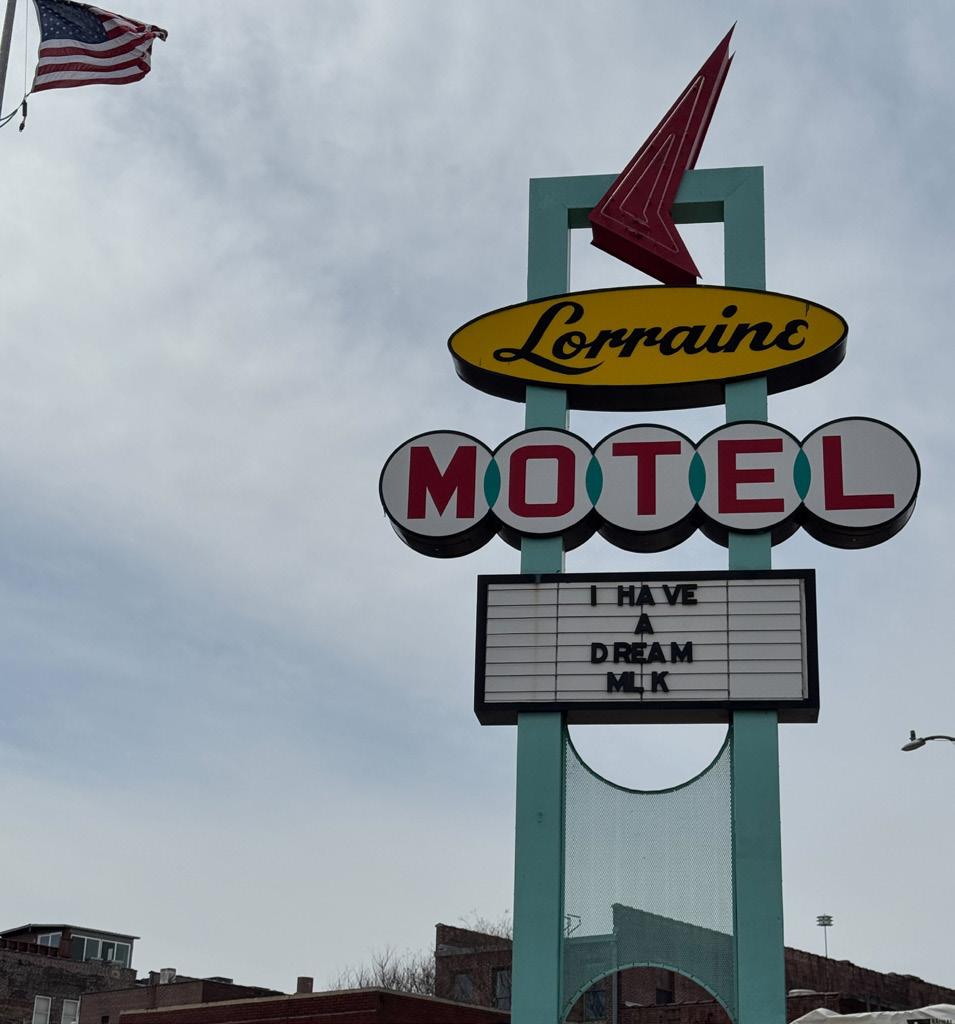
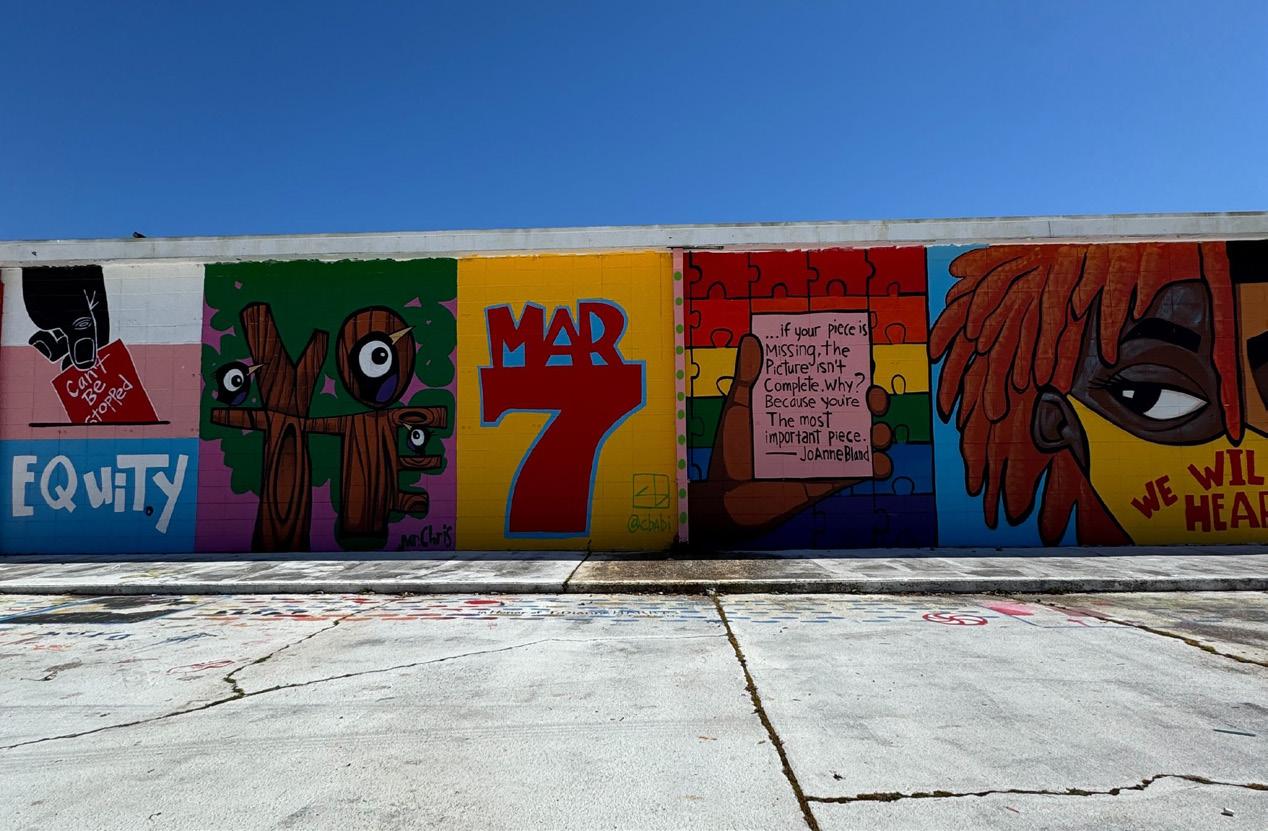
In this final picture, you may recognize this motel or you may have heard its name, The Lorraine Motel. This notorious motel is located in Memphis, Tennessee, and whether or not you’ve heard of it before, let me tell you about its history for a brief moment. The Lorraine Motel is where Dr. King was assassinated and spent his last moments. He was in Memphis to support the sanitation workers in their protests. He marched with the workers wearing signs saying, “I Am A Man,” and supporting the sanitation workers' fight for better working conditions, higher pay, and equal treatment. He was only 39 years old when his life was cut short, He was killed for doing the right thing and standing up for what he believed in. When you listen to his last speech, the “Mountain Top,” he mentions death and the tone in his voice sounds different from his prior speeches, indicating he may have had a feeling his time was coming to an end. The motel is now a Civil Rights Museum and a historic landmark in America.
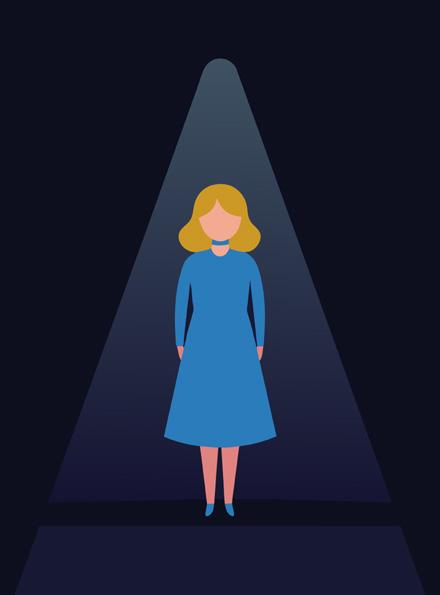


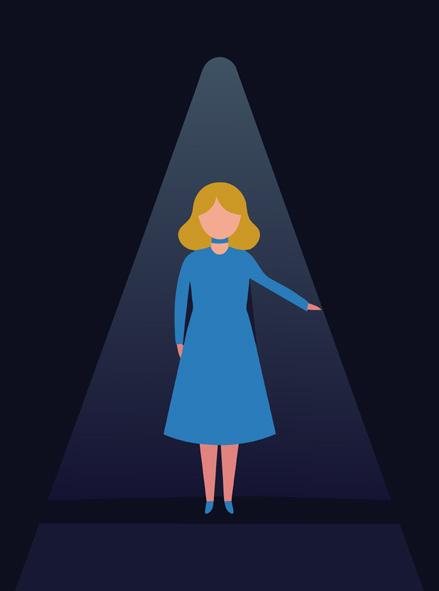
They hold hands to grieve me together. I’m not gone yet. They’re watching. I’m slowly dying. All victims of the bystander effect.
I’ll mean something more to somebody someday. Can I wait for someday? When will it be too late?
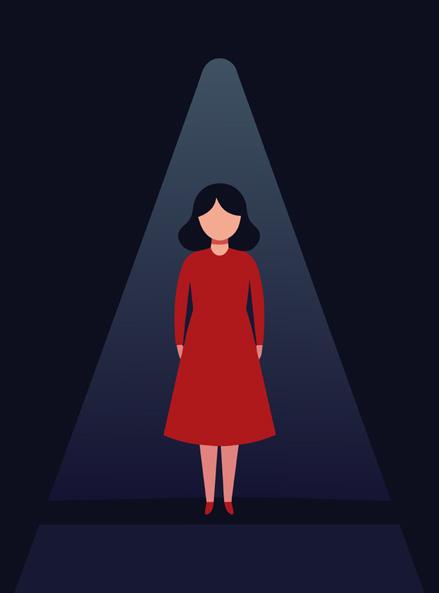
I can hear the echoes from the hall:
“She was so young,”
“So much potential,”
“So much beauty,”
“She will be missed.”
They forget now all the trouble I am. Or I was? Or I will have been?
All the sad sighs. Wishing I could get better. Willing me to get better. Feel better, be better. Feel happy, be happy. Why can’t I be happy?
I’m sorry I can’t be happy.
I can’t write a happy song. My pillows lay wrinkled and tear stained. As I ignore the notifications screaming at me.
Why do they find myself in my room writing eulogies to a living girl?
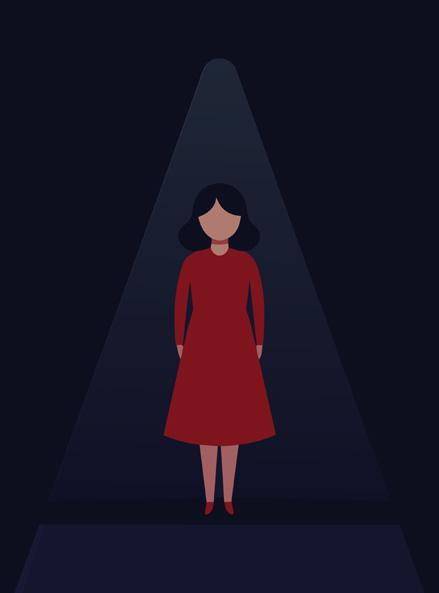

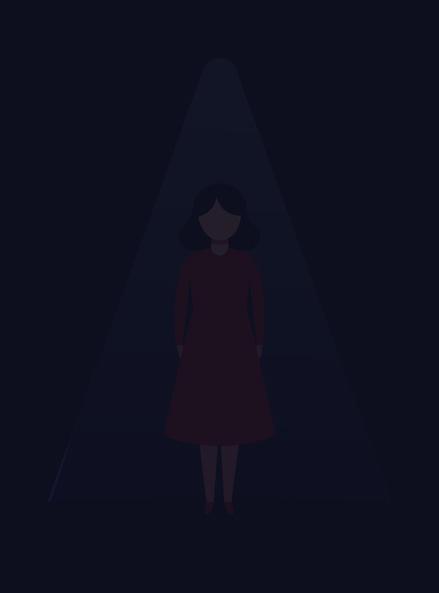
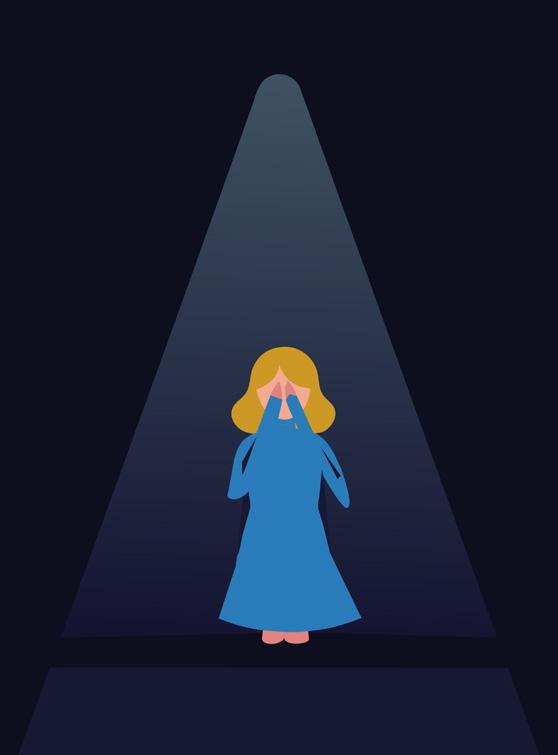

Funeral song come into the queue, And I remember, I too now am singing at a funeral tomorrow.
To a girl a year younger than me.
I forget now any trouble she was. My room fills with sad sighs.
I think about how young she was, her potential, her beauty; Oh, how she will be missed.
I know now, I have to get better. Feel better. Stay better.
Just stay alive.
I don’t want someone else to have to write a eulogy to a girl.
There are resources available in times of crisis, such as the national hotline. The University of Evansville also provides counseling services on campus and can refer you to outside providers if needed.
Please seek help if you are in need of it, you are not alone.
National Suicide Hotline: 988
UE Mental Health Resources: Office of Counseling and Disability Services
- (812) 488-2663
- disabilityservices@evansville.edu
- counselingservices@evansville.edu
- Office Located on the Second Floor of the Ridgway University Center
Mental Health and Wellness Clinic and Emily M. young Assessment Center - (812) 488-5640
- 1931 Lincoln Ave Suite A, Evansville, IN 47714
Here is a QR code linking to more free online resources from the CDC

The rise of artificial intelligence (AI) tools like ChatGPT has sparked a lot of discussions about their impact on students. Some people argue that these tools are making students lazy by providing easy answers and taking away the need for critical thinking. Others believe that ChatGPT can actually be a helpful learning tool, supporting students in grasping concepts, improving their writing, and saving time. So, is ChatGPT making students lazy or helping them? The answer really depends on how it’s used.
On one side, it’s easy to see how ChatGPT could encourage laziness if students lean on it too much. For example, a student might use the tool to write entire essays or finish assignments without actually learning the material. This can lead to students becoming disengaged from the work and relying on technology instead of building important skills like critical thinking, problem-solving, and independent research. In these cases, the tool could replace the effort needed to truly understand the subject.
However, when used the right way, ChatGPT can actually be a helpful educational tool. It offers students quick access to information, helps clarify doubts, and makes complex ideas easier to understand. For example, students who are struggling with writing can use ChatGPT to brainstorm ideas, organize their thoughts, or even improve their language. It can also explain tough concepts in a way that matches the student’s level of understanding. In this way, ChatGPT can make learning more efficient and free up time for students to dive deeper into the material.
The key to making sure ChatGPT helps rather than hinders students is how it’s used. If students view it as a tool to support their learning instead of replacing their own effort, it can enhance their educational experience. Teachers also play a role by guiding students on how to use AI tools effectively while still encouraging independent thinking and effort.
In the end, ChatGPT has the potential to either make students lazy or be a useful resource for their education, depending on how it’s applied. Like any tool, its success relies on the user’s approach. When used responsibly, ChatGPT can help students learn more efficiently and stay engaged with the material.
The history of feminist movements often focuses predominantly on white women, positioning them as the protagonists in the struggle for gender equality. However, taking a revisionist approach reveals a complex narrative filled with diverse voices and struggles that challenge the foundations of firstwave feminism. Important text such as Sisters in Spirit: Haudenosaunee (Iroquois) Influence on Early American Feminists by Sally Roesch Wagner, 2004 film Iron Jawed Angels directed by Katja Von Garnier and the journalism well as the writings of Ida B. Wells, illuminate perspectives previously hidden from mainstream accounts. By solely emphasizing the hegemonic narrative of white women in early American feminism, the contributions from marginalized groups, particularly Native American and Black activists, have been erased. Centering these overlooked voices expands our understanding of the feminist movement significantly.
provided Euro-American women, who were oppressed within their own culture, a powerful example and inspiration to fight for their rights.
Similarly, the film Iron Jawed Angels addresses the militant methods of suffragists like Alice Paul but often
their broader lessons regarding universal equality.
Decentering white narratives requires recognizing that feminist history is deeply intertwined with racial justice and Native American sovereignty. Wagner asserts, “They believed women’s liberation was possible because they knew liberated women, women who possessed rights beyond their wildest imagination: Haudenosaunee women”. Despite this powerful example, Euro-Americans adapted these ideals selectively, maintaining patriarchal control and racial hierarchies.
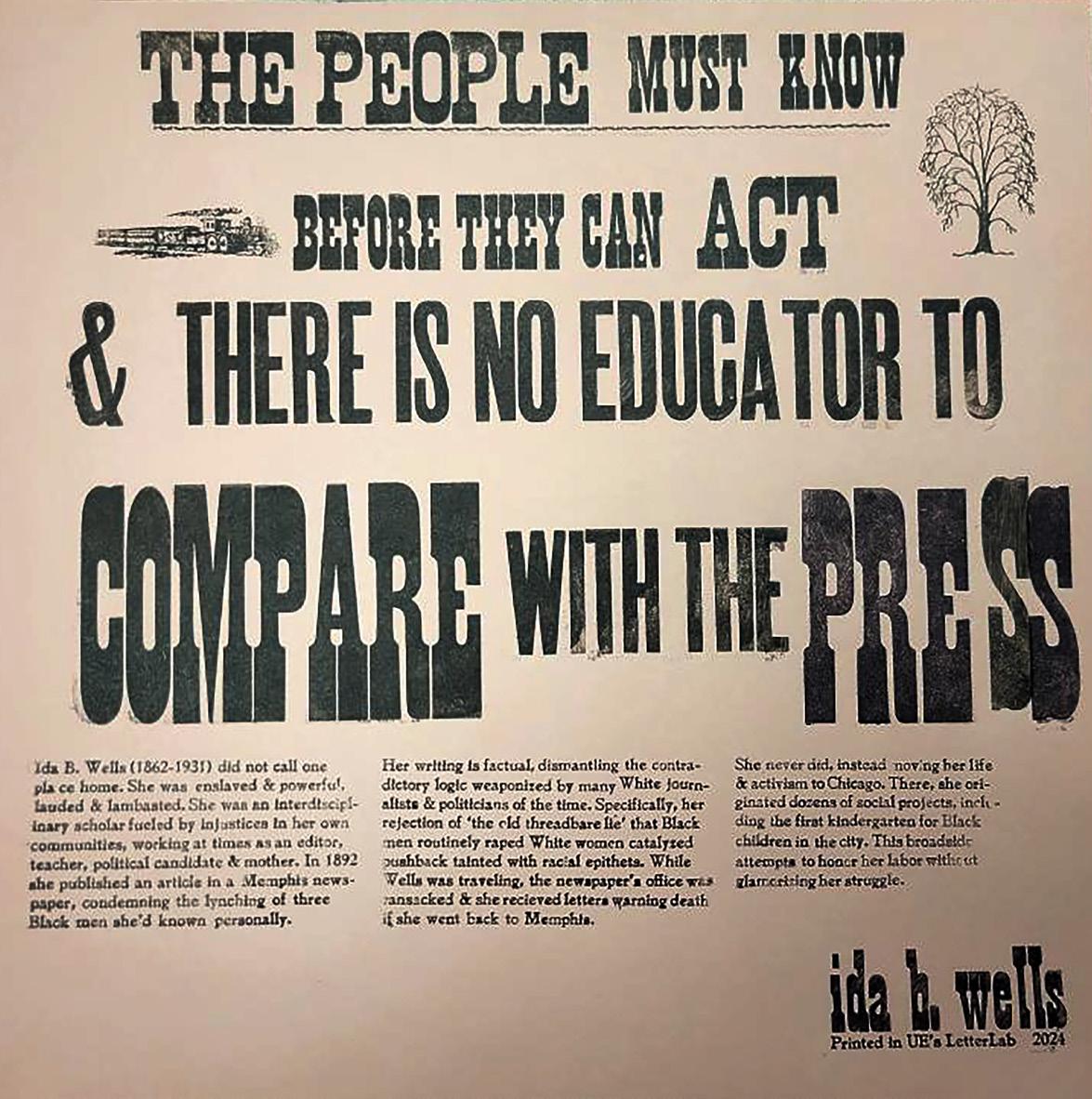
The problem with exclusively highlighting white women in feminist movements is that it obscures the representation and foundational contributions of minorities who supported and influenced the movement from its inception. In Sisters in Spirit, Wagner emphasizes how Haudenosaunee women held significant political authority within their society, offering an influential model for early American feminists such as Lucretia Mott. The economic and spiritual systems of the Haudenosaunee
neglect the parallel struggles of Black activists such as Ida B. Wells. Wells fought tirelessly not only for women’s suffrage but against racial oppression, exposing deep-rooted racism within the suffrage movement itself. Sisters in Spirit highlights this by stating, “Taken together, these tactics reveal the EuroAmerican practice of denying women suffrage to be an arbitrary exercise of male power”. By following the examples of cultures like the Haudenosaunee, white suffragists found models of political equality but selectively ignored
Learning from Black and Native American activism reveals that feminist movements are not homogenous struggles and must be understood through their intersections with racism, colonialism, and class oppression. Ida B. Wells directly challenged the suffrage movement, demonstrating the power of intersectional activism. Her activism highlighted that feminism is not just a genderbased fight but an ongoing battle against multiple overlapping forms of oppression.
Ultimately, broadening the narrative of feminism requires incorporating the diverse struggles of marginalized groups. By acknowledging intersectionality and moving beyond limitations of race and class, a deeper and more accurate feminist history can emerge—one that genuinely represents all voices integral to the pursuit of gender equality.
Zorah Mehrzad
“Everything feels so hopeless. I just don’t know what to do.”
“Everything feels so hopeless. I just don’t know what to do,” is a sentiment that seems to have grown increasingly common. The world as it currently stands is exhausting and difficult and coming at all of us very fast. For some people, that’s a newer feeling. For others, it’s the same, tired routine. Regardless of where you fit on the spectrum of awareness when it comes to the state of society, it’s important to not allow those overwhelming feelings of helplessness and despair to keep you from trying to make the world even just a teeny bit more livable. I personally believe very firmly in universal human dignity and our responsibility to uphold it. I also believe that everyone has a duty to those around them, whether they are strangers or loved ones, classmates you see for three hours a week or a best friend you’ve known your whole life. The idea that we “don’t owe anyone anything” is not only nonsensical, but completely counterintuitive to the desire people have for community. Your community, your village, your found family exists in the spaces you carve out when you’re doing things simply for the sake of others, with zero expectations in return. And with luck, this short guide will give you a starting point for how to take actionable steps toward improving the world around you, making those little ripples with the hope that they turn into big waves somewhere down the line.
The idea of a “social change ecosystem” allows for the establishment of various archetypes, roles that people need to take on in order to implement any real change in a society. It can work on an individual or organization-sized level. It’s flexible and inclusive of the
different circumstances people may find themselves in. It insists that change can be brought about by anyone from any angle. I prefer the concept because of its aversion to limits and find that it offers a myriad perspective of what it means to put positive action out into the world. This one in particular was developed by the Building Movement Project, so I encourage consulting their guide for further details.
The role of a Weaver is primarily an organizational one. As defined by the Building Movement Project’s guide, they “see the through-lines of connectivity between people, places, organizations, ideas, and movements.” In essence, a Weaver is someone who can see the parts of a cause that are unifying, and highlight those for the benefit of others, often making them particularly adept at leading. If you feel drawn to helping other people find a place and a fight worth fighting, it would be worth it to begin joining in on social issues you feel particularly drawn to so that you may unite groups together into a coalition or committee. One easy way to start is by looking on UEngage for clubs that promote similar ideals to you. Most of the organizations on campus are relatively small, allowing you access to people who may have connections outside of the student body, linking you to local or even national movements.
An Experimenter is someone who is interested in innovation, risk-taking, and
pioneering new ways to approach social problems. They tend to be flexible, making them especially important when movements hit a standstill. When it comes to small, grassroots organizing, Experimenters can help in keeping the group moving forward and are similar to Disrupters, which we will explore later. The major distinction, however, is that Experimenters work within the group rather than taking actions outside the group. From what it looks like, they’d work well with Weavers to get things organized and keep it all rolling, so if you’re someone who would enjoy providing energy and support to those who are setting out goals, this might be the role for you. One way to approach becoming an Experimenter is to consider the ways that certain objectives can be achieved and then finding the best, most energizing way to get there.
Another, more leader-oriented role, Frontline Responders are best in times of crisis, organizing a network of resources and communications for the community. People who are prepared to work in high-stress situations and are comfortable networking would be best fit for the jobs of a Frontline Responder. It’s also important to consider the necessity of having a team of Frontline Responders, as there is no possible way to face large crises alone. Being a team player will be essential to this role, in addition to the ability to prioritize tasks in order to make the most positive change. I encourage people to read Lifehouse by Adam Greenfield, even if it’s just the preface. He addresses the way that New Yorkers
responded to Hurricane Sandy, helping their communities where governmental agencies failed. Frontline Responders would be the lifeblood of a structure like a Lifehouse, a beacon for people during a critical period. Learning about the most pressing catastrophes facing your community, be it homelessness, food insecurity, or natural disasters, and looking at who all is already dedicated to alleviating the pain would be a good place to start. Get involved with local shelters, food pantries, organizations that are working to provide safe spaces for kids. Take a training with the Red Cross or a harm reduction clinic. These groups are good ways to get on-the-job training for potential emergencies.
As much as we need pragmatic and grounded members of this ecosystem, we also need people who see the world as a blank canvas upon which we can paint our greatest creation. Visionaries are essentially the compass, generating bold ideals for the future and maintaining that direction for all other members. Similar to the Experimenter, they are pioneers, but their goal is to create a sense of encouragement more than anything else. To be a Visionary means possessing a radical imagination, and for that I encourage taking a look at the book Let This Radicalize You by Kelly Hayes and Mariame Kaba. Just in the foreword, Maya Schenwar talks about meeting Kaba in a coffee shop and being confronted with the question, “Well, what do you think we should do?” This was Kaba’s response every time Schenwar asked for Kaba’s opinion on what should be done to address some social ill. Kaba was insisting that Schenwar think for herself, creating a future she’d most want to live in. For the Visionaries, this is a role to be taken on for the good of focusing the group. Synthesize the future you want, the future those around you share, and make it bigger and brighter. Then set yourself to the task of keeping the momentum going toward that target, even when things get difficult.
If Frontline Responders are manning the Lifehouse, then Builders are the ones to construct it. As a Builder, you would look at a problem, find a solution,
and implement it into existence. The primary job of a Builder is to make tangible the ideas of the Experimenter and the Visionary. Take the blueprint and turn it real. This will require planning and teamwork, direction and drive. It also requires trusting in and believing in the vision of the group as a whole, since the Builder’s role will seem much more obvious to onlookers. If you’re someone who enjoys “doing” instead of just “conceptualizing,” this is probably the path you’d most enjoy taking. If someone says they are lacking access to birth control, a problem the group feels is best solved by finding the resources to provide free birth control, then the Builder can find organizations that supply birth control vending machines. They can work with that org to then install said vending machine, finding a solution to the problem that will make a material impact.
In every fight, it is important to have people around that are willing to be the support. As a Caregiver, the bulk of your responsibility would be on the wellbeing of those around you, ensuring that they are properly taken care of so they can carry out their intended tasks. One way this can work is to provide meals to those working on a labor-intensive project. Maybe it’s as simple as making sandwiches for your neighbors as they fix a fellow neighbor’s broken porch steps, or maybe it’s something larger like ordering pizza for union workers on strike. Sometimes it might be opening up your home to coalition members for a film night or being a shoulder to cry on. Big or small, the Caregivers of a social change ecosystem should be ready to bolster others around them to the best of their abilities.
Similar to Caregivers, Healers are focused on the wellness of those around them. That being said, their focus is more clinical, a careful attention to the traumas created by systems and policies, institutions and the powers that be. They are tasked with trying to dismantle the things that are hurting us in our society, those baked-in, invisible forces that make it harder for people to live, while also finding nuanced ways
to navigate the pains that those forces have already caused. It’s incredibly painstaking, taking on systemic racism or transphobia or the patriarchy, but it’s a job for those who are adept at excising the pain so that it doesn’t plague us anymore. Get comfortable addressing people in positions of authority, attend city council meetings to petition for city-wide changes to policy, find the people at your institution who want the atmosphere to be more inclusive and band together to make sure change is carried out. Look at the ways that the environment you exist in can be more comfortable for everyone and chase those possibilities.
In my mind, Disrupters are pretty much the people willing to get down and dirty in order to achieve their goals. Think direct action members, people shutting down arms factories to prevent weapons shipments that will no doubt be used to slaughter people in Palestine, in Congo, in Sudan, in Kashmir. These are people who are fine with getting yelled at, getting arrested, facing down cops in riot gear. They’re okay with being in dangerous situations, but most importantly, are not taking risks simply for the sake of taking risks. One thing that some people don’t realize is that organizing doesn’t work when people decide to go rouge and endanger others around them. You need trust, and in this case, Disrupters are required to maintain an intense level of trust with their fellow companions. If there are an inordinate amount of cops at a protest, they will feel comfortable standing at the front of the line but should also be the most knowledgeable in how to direct anti-kettle formations and how to perform de-arrests. There is an important balance to be struck when you’re willing to put yourself right in the heat of it all, and a Disrupter should be able to do just that.
In the process of tearing down oppressive systems, there needs to be people who are dedicated to preserving the history of the movement. If there are groups suffering under a regime, there should be others taking notes and keeping the stories of the community alive. This is the task of Storytellers,
individuals who are good with recording experiences, cultures, and narratives in ways that not only keep them safe and true, but also allow them to be distributed. Art, music, movement, and other forms of media are the main tools in a Storyteller’s toolkit. Writing for your local student magazine, filming a documentary on a topic that matters to you, going into the National Archives and preserving the legacies of people that the government would rather forget are just a few of the ways you can lend your energy to a movement. Team up with others who are looking to make sure every voice is heard, then keep people from forgetting the good and bad things that happen in the world.
While many of the other roles in this ecosystem are ones that can be joined at any stage in your organizing journey, Guides tend to have inherited the position based on prior experience. Teaching, counseling, and advising are the main jobs Guides are tasked with, making them the main resource for people who are just entering into an organizing space. They should be patient and discerning, ready to answer questions while also gradually pushing new members into deeper waters, where they will learn how to find a place for themselves. It’s a role for personable people who are focused most on the ways to help people feel at home, like they have a purpose, like they will figure it all out. They are the gateway, but never the gatekeeper. Some ways to get started in being a Guide would be anything as simple as writing a “How-To Manual” on a topic you are familiar with, sharing your knowledge with others, or you can take people under your wing when they join a cause you’ve already been an active part of. The main goal is simply to grow your movement to the best of your abilities, in a way that is sustainable and grounding for everyone involved.
And while I think that personal responsibility can only go so far in a society that is largely damaged at the hands of corporations and the rich, there are some personal actions you can take. They’re not going to make huge impacts globally on their own, but they will certainly improve your sense
of control and, when combined with the efforts of others worldwide, have the potential to make massive amounts of change. See what you’re able to implement.
1. Pick every non-plastic option you can
2. Cut down on your consumerism wherever possible
3. Go to the library, go to the library, go to the library (if you can’t go, at least use the apps, Libby and Hoopla)
4. Learn how to administer Narcan and carry a bottle on you just in case
5. Compost your food scraps if you have the space
6. Learn basic first aid
7. Join organizations like Students for Justice in Palestine, the Intersectional Feminist Alliance, the Intersectional Pro-Choice Assembly, any of the student unions, or other service based groups
8. Figure out what resources your town has for new immigrants
9. Bear witness to the genocides being committed around the world
10. Don’t cross the picket line!! (learn what union workers are striking and then do what you can to support them)
11. Boycott goods that come from or have close ties to Israel and the UAE
12. Learn why you should be boycotting products from Israel and the UAE
13. Attend a teach-in on a topic that resonates with you (there are so many online!)
14. Join a coalition or a club or an organization or a book club!! Find your people!!
The last thing I’ll leave you with is a list of some resources and people to follow. These are the places I go to learn, connect, and grow, so maybe they’re not all to your taste. But I do hope they serve as a solid jumping off point in some way.
1. @frontlinemedics: Mainly made up of medical workers, the Frontline Medics Collective is a great place to get information regarding healthcare. They’re also Indigenously-focused, meaning that their work examines alternatives outside of a Western framework.
2. @ismatu.gwendolyn: Ismatu Gwendolyn is a mental health practitioner who made the radical decision to stop charging clients and essentially live off of mutual aid. They have amazing insights into the role of the artist, the importance of community, and what it means to look out for others.
3. @slowearthfactory: A liberatory collective that also puts out their own “textbooks,” Slow Earth Factory offers online courses and seminars, some of them completely free of charge. Others require payment, but their resources are vast, so they have plenty to learn from at no cost to yourself.
TikTok
1. @crutches_and_spice: Imani Barbarin has an Instagram and a blog as well, but Tiktok is the place I found her first. She’s my personal go-to for information on combatting ableism and learning more about disability rights.
2. @HillmanTokUniversity: A collection of Black educators and professionals, HillmanTok is a digital phenomenon to keep up with. There are hundreds of courses up for free, all conveniently available on TikTok.
Book Presses
1. Verso: I might actually have a slight spending problem when it comes to Verso, but they are really nice to provide ebooks with every purchase of a physical book, or you can just get the ebook. They also publish a blog on their site in case you don’t want to spend money. Most of what Verso publishes
is nonfiction, but they also have some fiction.
2. Pluto Press: I’m mostly including this one because Pluto Press published a book called Pirate Care, and I need to wheedle my TBR down enough to justify buying it. They publish similar content to Verso. justify buying it. They publish similar content.
3. Haymarket Press: While Verso and Pluto Press often have sales, Haymarket Press is far more likely to have free ebooks from time to time. I got my copy of This Will Radicalize You from them during free ebook deal, which I will be forever happy about. ebook deal, which I will be forever happy about.
1.Democracy Now: Completely viewer funded, Democracy Now provides some of the best news coverage if you’re looking for a global perspective. Also, Amy Goodman is just the GOAT, so, that’s a plus.
fireside.evansville.edu